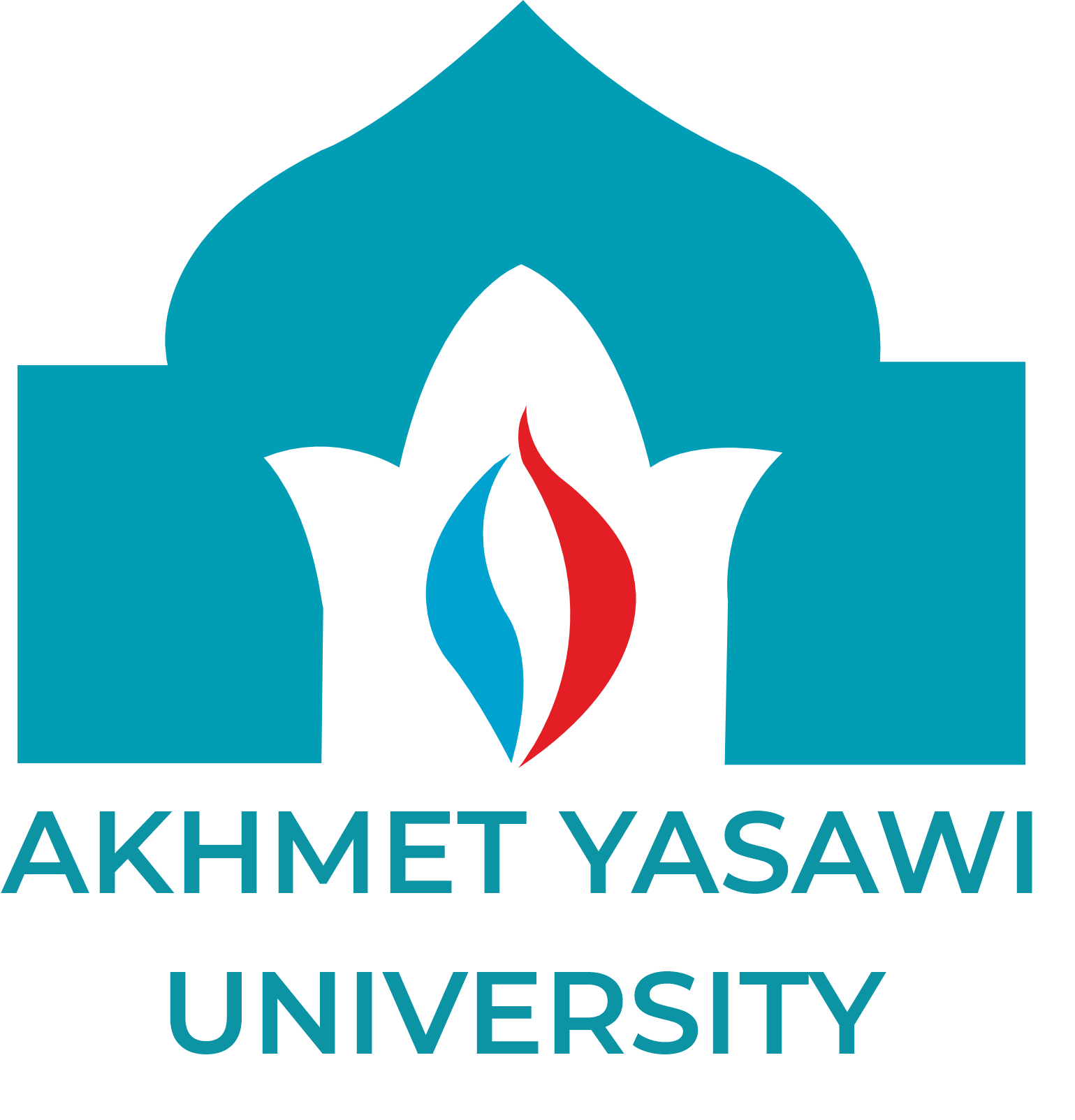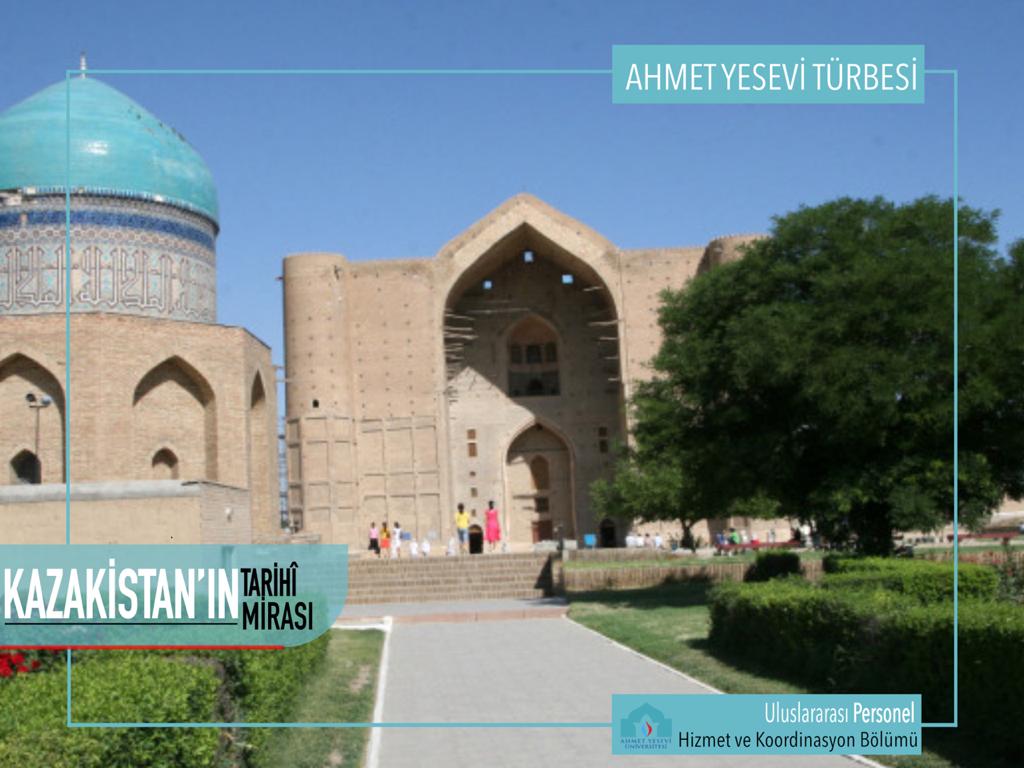
TOMB OF KHOJA AHMET YESEVI
The mausoleum of Khoja Ahmet Yesevi in Turkestan is an outstanding example of medieval architecture. Khoja Ahmet Yesevi was a Turkish poet and the first Turkish mystic who lived between 1093 and 1166. After the death of Khoja Ahmet Yesevi, a small mausoleum was built where his grave was located. In the 12th century, instead of the small tomb, the construction of a new tomb was started in 1389 by the order of Timur. Timur brought mosaic masons from Shiraz and stone and plaster masters from Isfahan. The architect of the building was Hâce Hüseyin Shirazi from Iran. The mausoleum was built between 1389 and 1405.
The main entrance of the mausoleum measures 18.2 x18.2 m. The main section is known as Kazandik. This section is covered with a brick dome with a diameter of 18.2 m, the largest dome in Central Asia. In the centre of the Kazandık section there is a huge bronze cauldron called Tai Kazan, which was used for religious purposes. The sarcophagus of Khoja Ahmad Yassavi is located at the end of the building, in the centre of the sarcophagus section. The tomb section has a domed roof 28 metres high. The outside of the dome is covered with hexagonal green glazed tiles with gold patterns. The outer walls of Khoja Ahmed Yesevi Tomb are decorated with extremely distinguished examples of tile and calligraphy art.
The restoration of this building, which is a common treasure and cultural value of Turkish-Islamic culture and civilisation, was carried out by TIKA between 1993 and 2000. In 2003, the Mausoleum of Khoja Ahmed Yesevi, which was included in the world heritage list by UNESCO, is open to visitors as a museum. This building is of great religious and historical importance both because it is the eternal resting place of Khoja Ahmed Yassawi and because leading Kazakh khans were buried here.
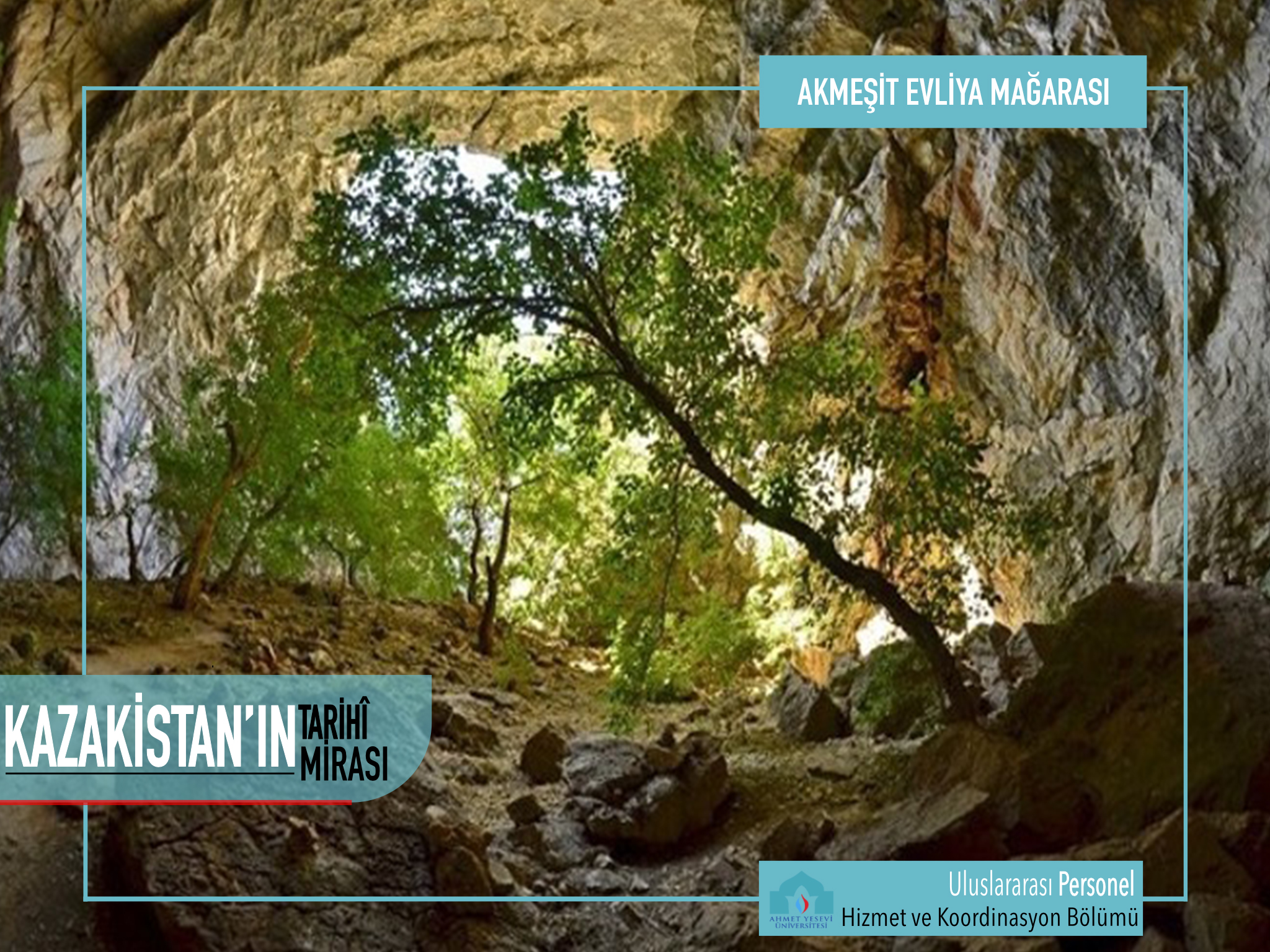
AKMEŞIT EVLIIA CAVE
It is located in Akmashit village of Baydibek district in Turkestan region.
The cave formed in the limestone rock layer is 254 m long, 65 m wide and 25 m high. From time to time water drips from the holes in the shell. From the inside the circle resembles the roof of a dormitory.
Some couples who cannot have children and sick people spend the night praying in the cave.
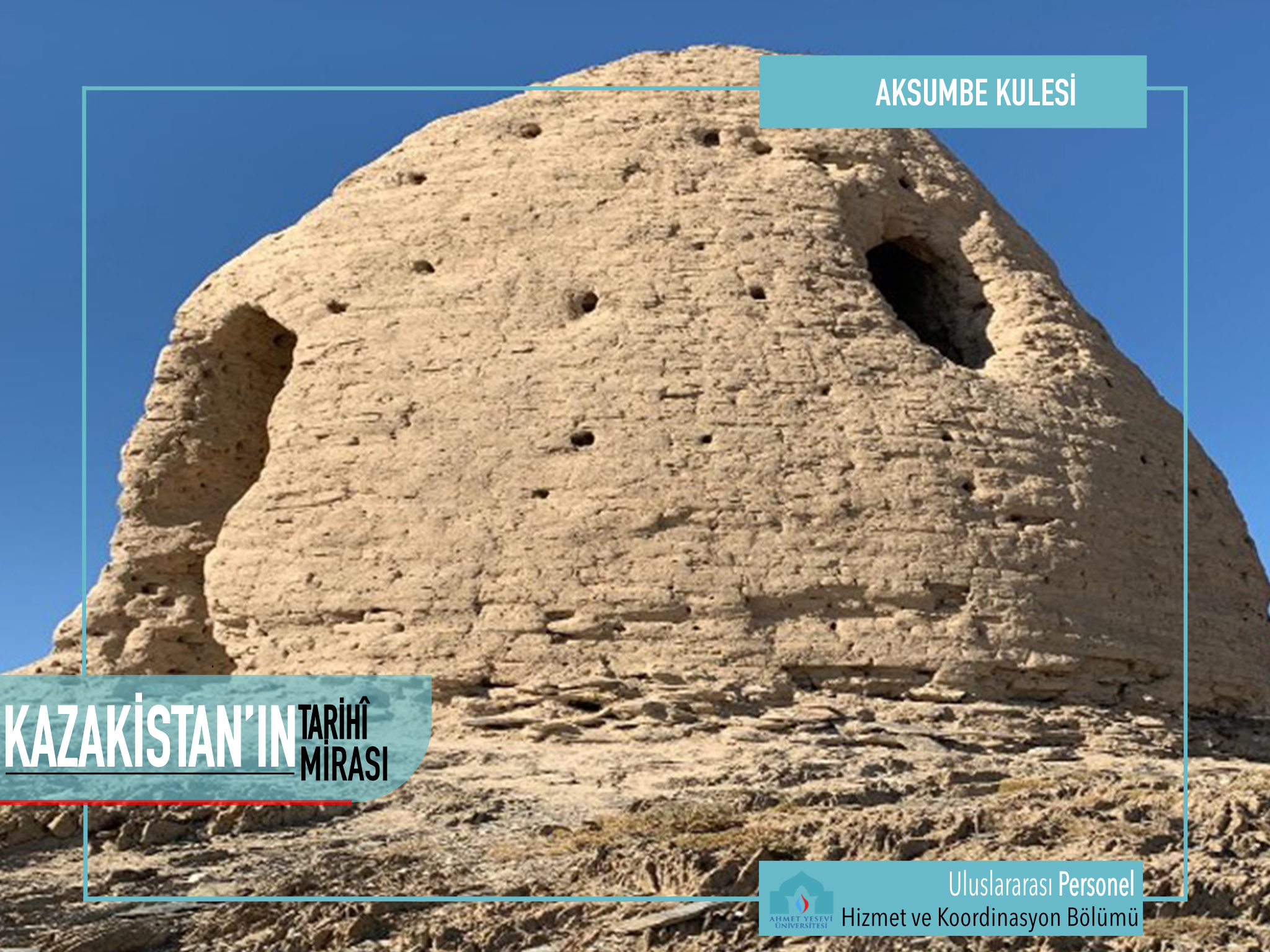
AKSUMBE TOWER
The tower is located in Aksumbe village of Suzak district. According to historical sources, it was built in the XIII century. It is written that it was built as a watchtower by the Dasht-i Kipchak tribe. The tower is in a high place. The tower is on a high place. It is made of mudbrick with a height of 11 m, which is preserved today. The stairs made of mud inside have been erased and only the places of the stairs were observed.
In 1946 an archaeological team led by academician A. Margulan and in 1947 by archaeologists E. Ageeva and G. Patsevich conducted research on the city. Based on the pottery found in the city, the researchers determined that the inhabitants of the city lived in the X-XIV centuries. The tower attracts tourists with its unique architecture.
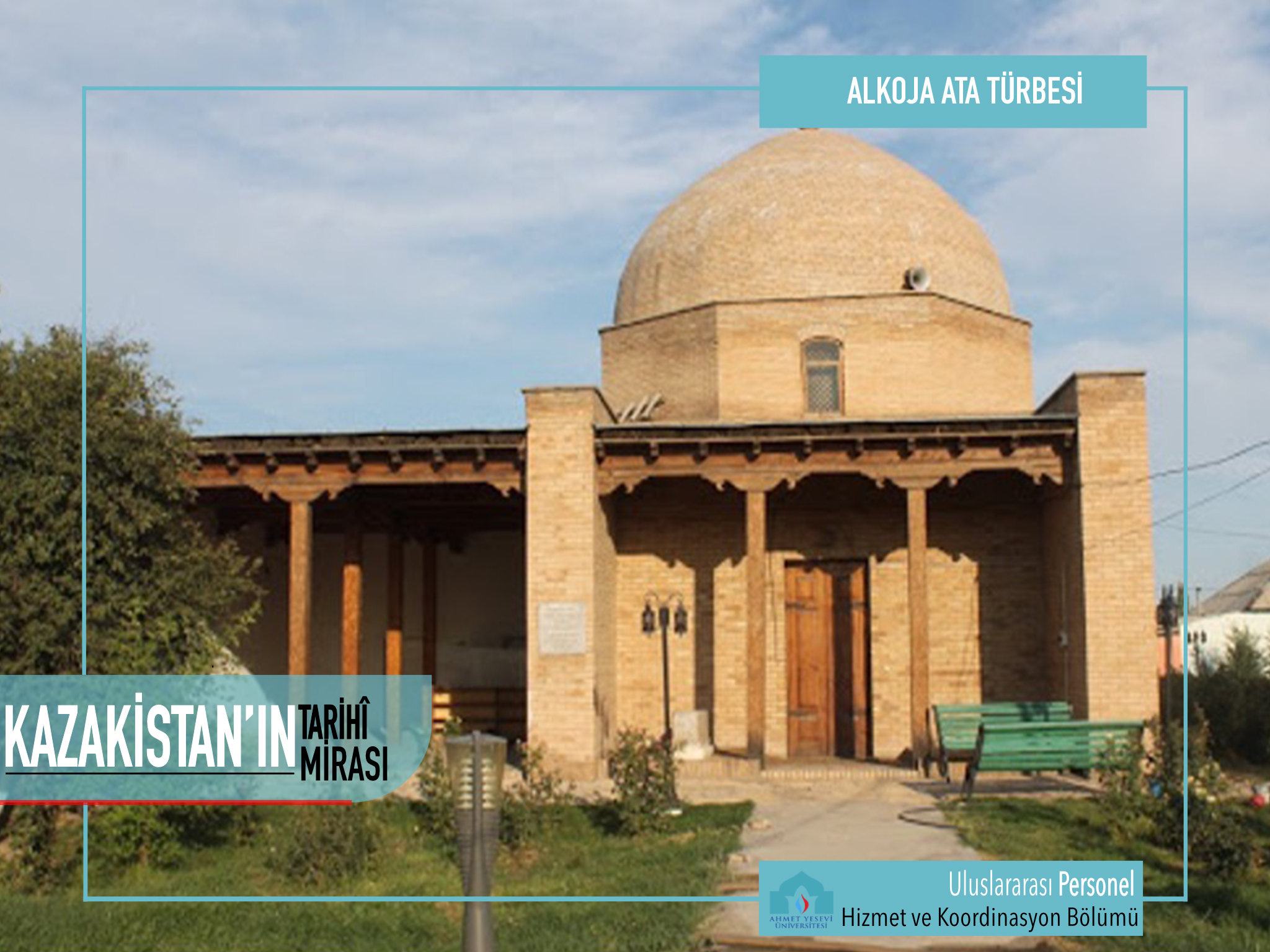
ALKOJA ATA MAUSOLEUM
From the main structure of the mausoleum, built in the XII-XIII centuries, only the tombstone has survived to our days. In 1998-1999 the mausoleum was reconstructed by "Kazrestavratsiya". The two-domed mausoleum consists of a cemetery, mausoleum and mosque. There are 5 graves in the cemetery. It is said that these are the graves of Ata's children.
According to folk legends and stories, Alkoja Ata was the son-in-law of Khoja Ahmet Yesevi, the wife of Mother Gavhar. During this period he spread knowledge and justice. Local people also call Ata "Ali Khoja" or "Ali Khoja Amir Diwana (Majnun)". The mausoleum built on the tomb of Alkoja Ata has become a place of pilgrimage and a mosque.

APPAK ISAN MOSQUE
This building is located in the village of Shayan, Baydibek district. Initially, with the help of many people, a small brick mosque was built instead of this mosque. Appak Ishan Madrasah is arranged as a letter (П). The madrasah consists of a total of 32 rooms, including 4 educational, 3 corridors, 25 study rooms. The madrasah has one floor. It has a total area of 50x50 m and room size of 3x6 m. The entrance to each room is decorated with an arch. The doors of the rooms are wooden. There are small windows above the doors.
This building is of great interest to tourists as an architectural monument.
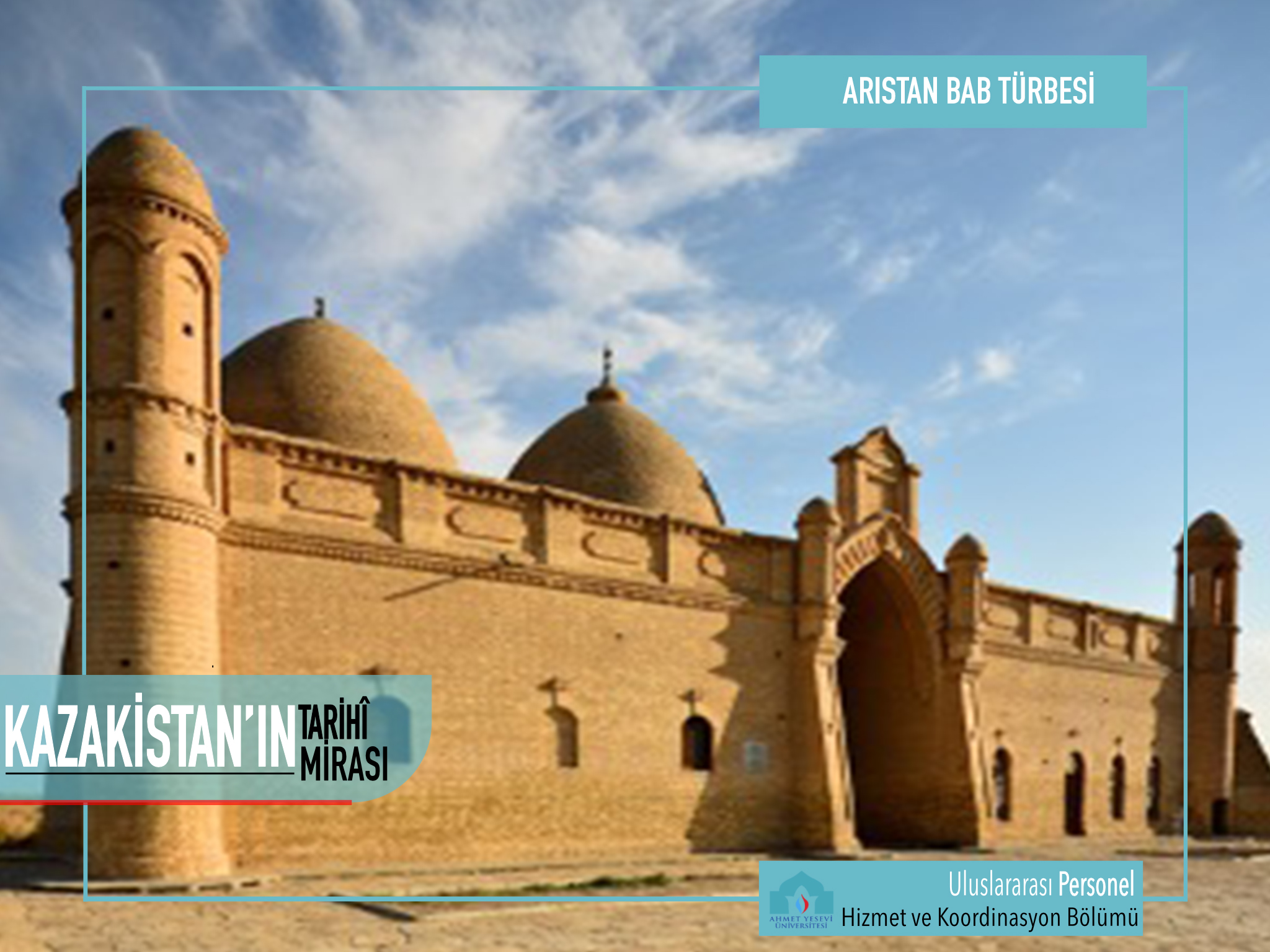
ARISTAN BAB MAUSOLEUM
The mausoleum is located 3 km north-west of Kogam village in Otrar Region. The mausoleum was built on the graveyard of Arıstan Bab (Arslan Baba), the spiritual teacher of Khoja Ahmet Yesevi. The first construction of the mausoleum dates back to XIV-XV centuries. The carved wooden columns in the structure have been preserved until today. The mausoleum was destroyed in the earthquake of the 18th century (in 1909) and rebuilt.
In 1971, the mausoleum was destroyed by groundwater and rebuilt with the efforts of the local people. There is a great tourism value in the region; there are special areas for pilgrimage, accommodation and sacrifice. The tomb and its surroundings are one of the places where pilgrims stay throughout the year.
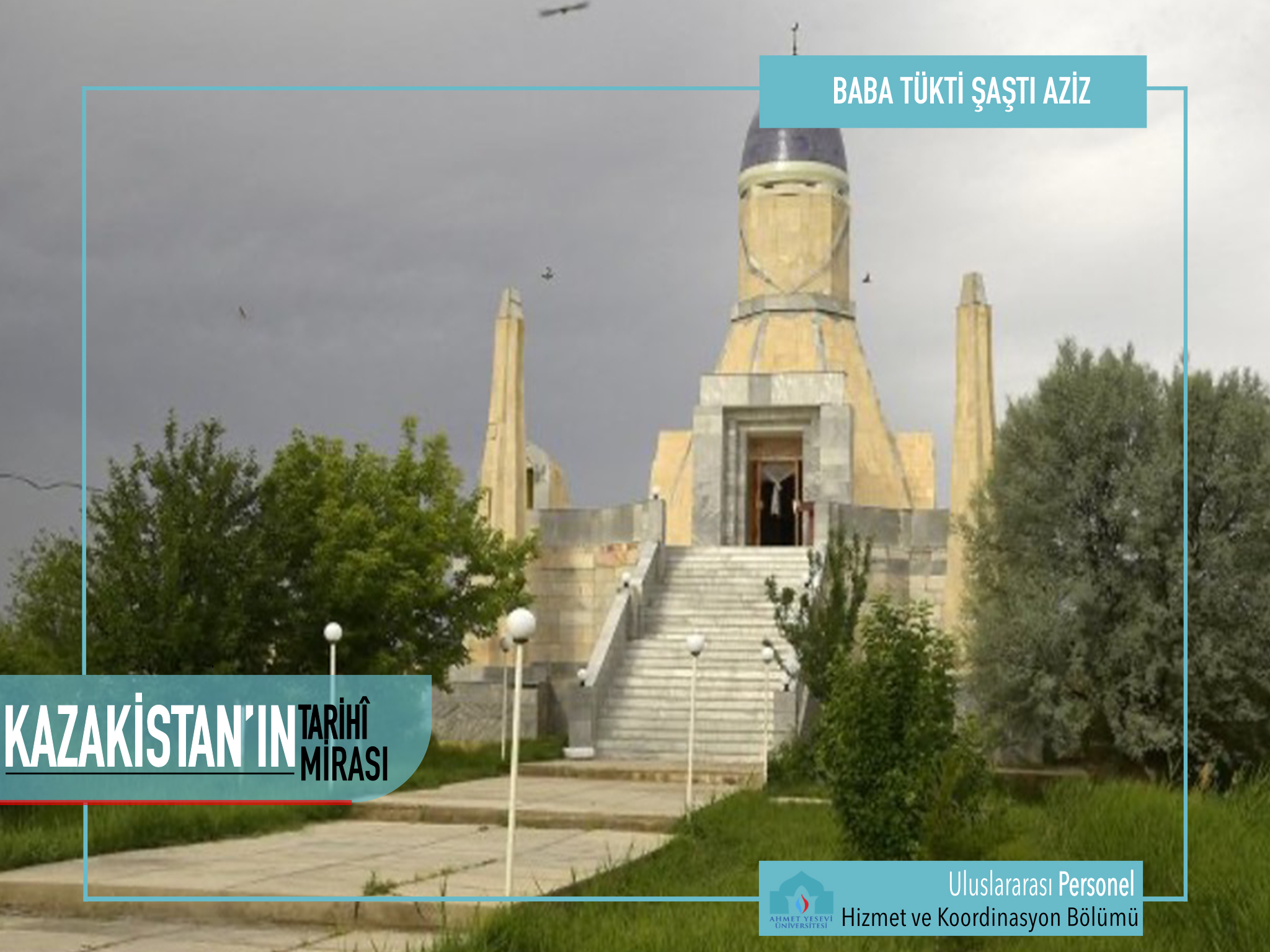
BABA TÜKTİ ŞAŞTI
It is located in the Jilibulak area near Kumkent village of Sozak district. Baba Tükti Shashti Aziz is a common image in Kazakh folklore and is considered a saint among Muslims. According to legend, Baba Tukhti Shashti Aziz was a contemporary and companion of Isaac Bab, an Islamic preacher in Central Asia and Kazakhstan.
His mausoleum in the Saint's cemetery is built of burnt bricks. It is a single-chambered tomb with a facade composition. It is surrounded by a quadrangular dome resting on a round neck. The facade is flat, unadorned, shallow and hollow with an entrance in the centre and a small relief tower on both sides. The interior has pointed arches in the core of the square house. The dome is placed on these arches. In the centre of the house is a tombstone made of brick. In addition, there is a candelabrum, a private mausoleum, accommodation rooms and an altar, which is known as a place of pilgrimage among the people.
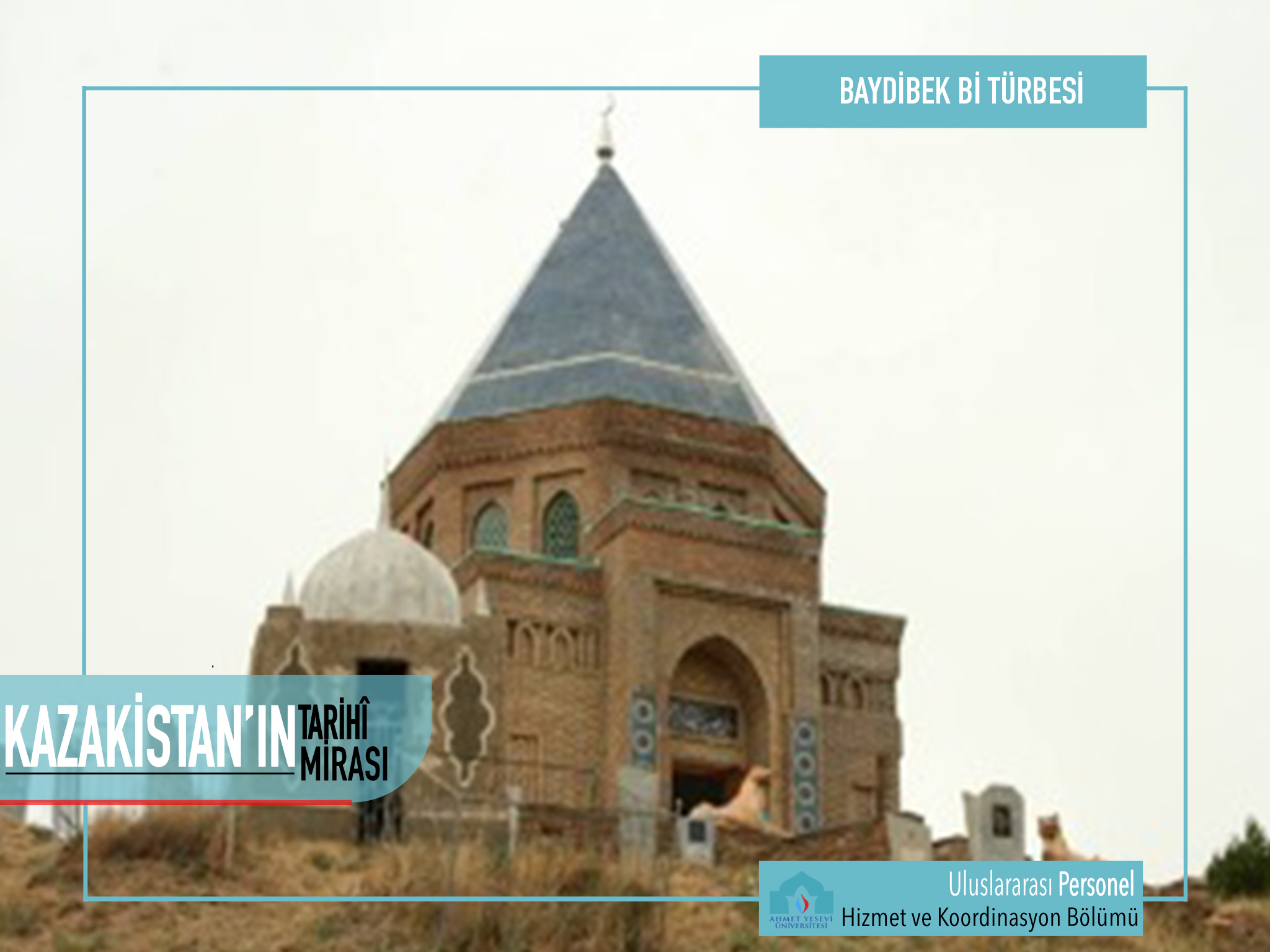
BAYDIBEK BI MAUSOLEUM
Baydibek Bi Mausoleum is located in the village of Baydibek Ata in Baydibek district of Turkestan. 1966 year on the high bank of the Balabogen River on the example of the Karakhanid Khanate period of Baydibek Karashauly, the dome of the ancient tomb, which had been preserved for a long time, was rebuilt in a new style. Masters from Samarkand, Tashkent, Sairam, Shymkent participated in the construction of Baydibek Ata Mausoleum.
In one of the rooms of the Baydibek Bi Mausoleum, the former President of the Republic of Kazakhstan Nursultan Abishuly Nazarbayev placed a statue of a cradle weighing 6 tonnes made of white marble.
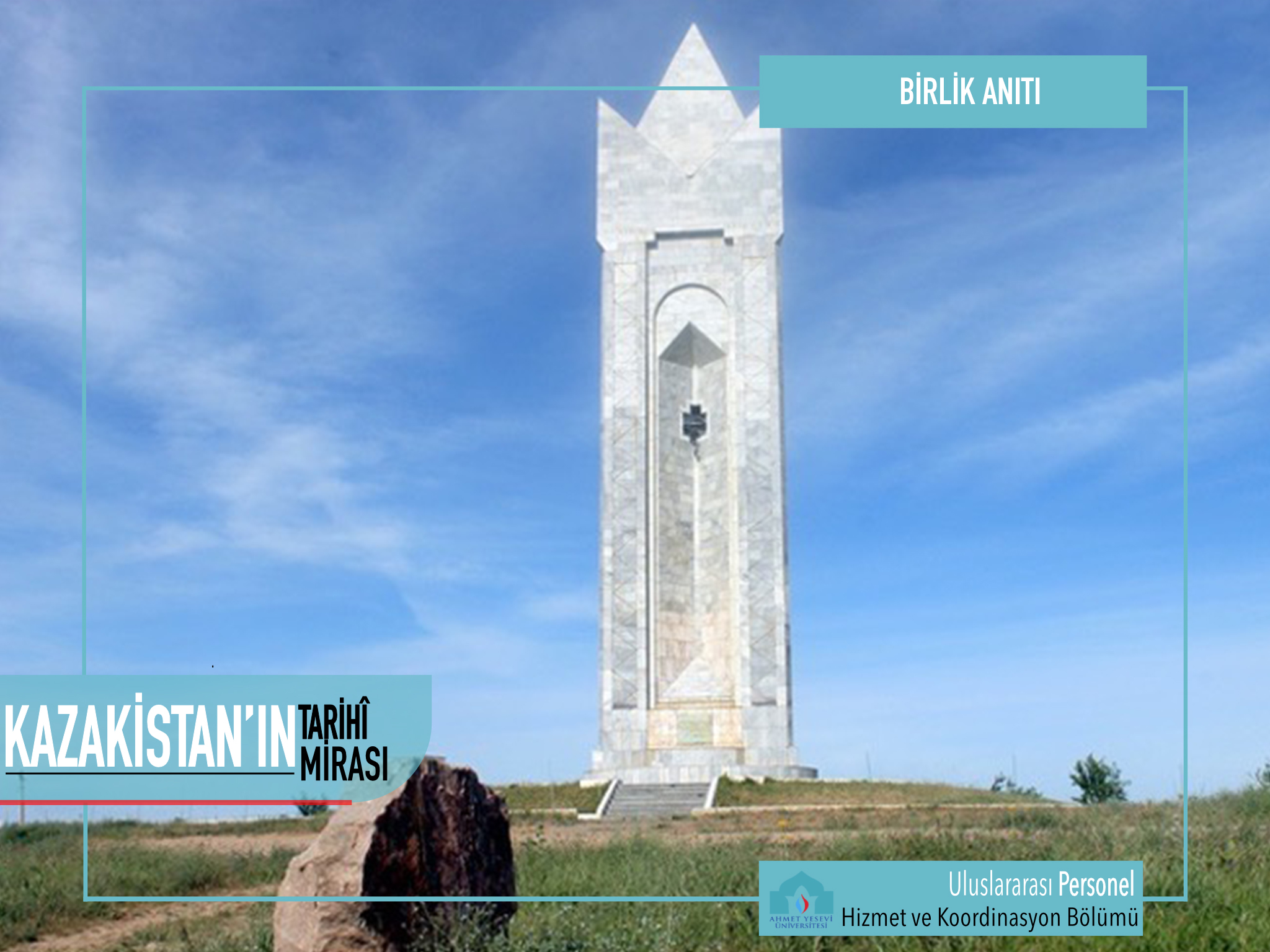
UNITY MEMORIAL
The Unity Monument is a source of prosperity and unity for the Kazakh people. The monument of unity is a monumental composition in the broad sense of the word, it is a triangle from three corners and depicts the personalities of three khans. Its fame seems to have spread to different regions of Kazakhstan: Syrdarya - to the west, to the Karatau Mountains - to the north, to the Kazygurt Mountains and to the south-east. On both sides of the stela there are plaques with the words of three great ancestors. The monument is 28 metres high and 8 metres wide.
On 19 September 1997 the construction of the monument was completed and the opening ceremony was attended by the first President of the Republic of Kazakhstan Nursultan Abishuly Nazarbayev.
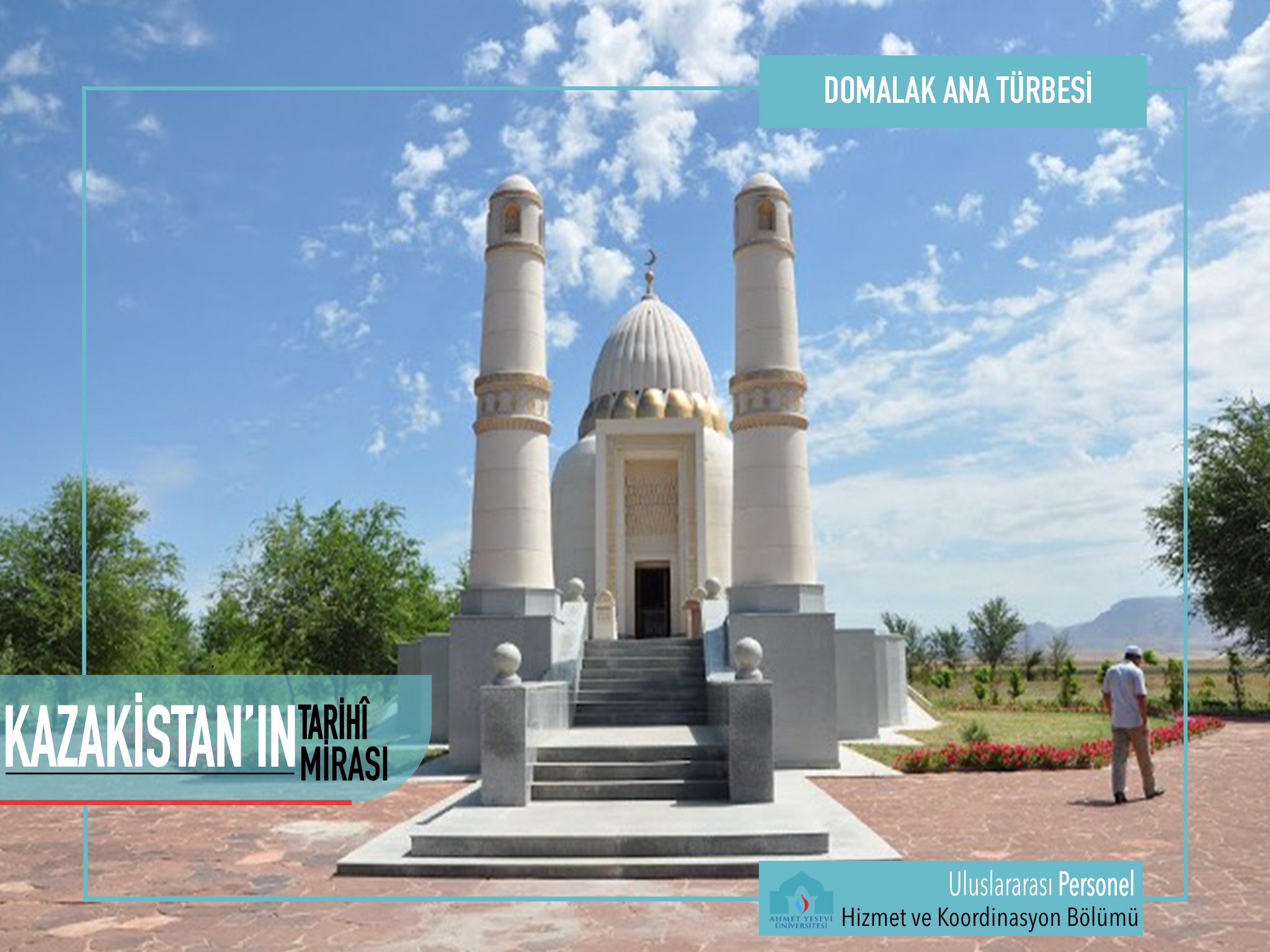
DOMALAK ANA MAUSOLEUM
Domalak Ana Tomb has been demolished, built and renovated many times. Domalak Ana's grandson Dulat brought a craftsman named Abdullah Sheri from Bukhara and had the mausoleum built for the first time in 1456. The mausoleum was renovated in 1957. In 1996-97, under the sponsorship of individual entrepreneurs, the mausoleum was rebuilt, redesigned by the famous architect Sain Nazarbekulu.
With new white stones specially brought from Mangistau, a dome was installed over the main section of the mausoleum with a 12-metre-high lattice of eight petals, and with this new construction the mausoleum underwent significant changes.
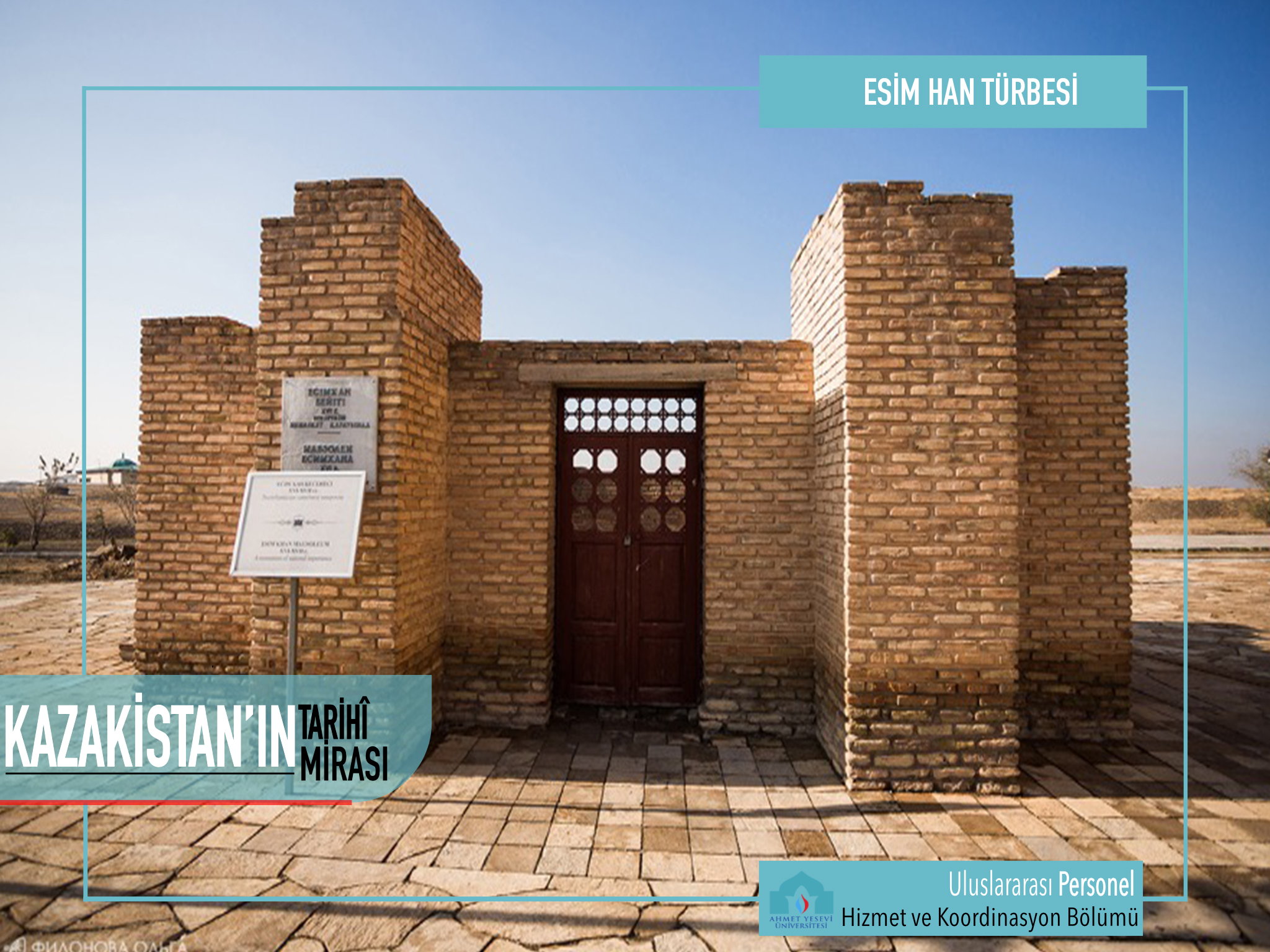
ESİM HAN MAUSOLEUM
The mausoleum of Esim Khan is an architectural monument in the city of Turkestan, preserved since the XVII century. It is located 12 m south of the west tower of Khoja Ahmet Yesevi Mausoleum. The mausoleum was built over the mausoleum of Esim Khan, khan of the Kazakh Khanate. It is thought that the destroyed mausoleum was probably destroyed in the late 18th and early 19th centuries.
The mausoleum is built of burnt bricks in a square (9x9 m). The main facade is in the form of a portal. The facades are decorated with geometric ornaments. The mausoleum has an entrance on the south-east side. The width of the preserved wall is 1,2 m. This shows that it could withstand the lifting of a high dome. The floor is paved with square oven bricks. The protected part of the mausoleum was renovated in 2000.
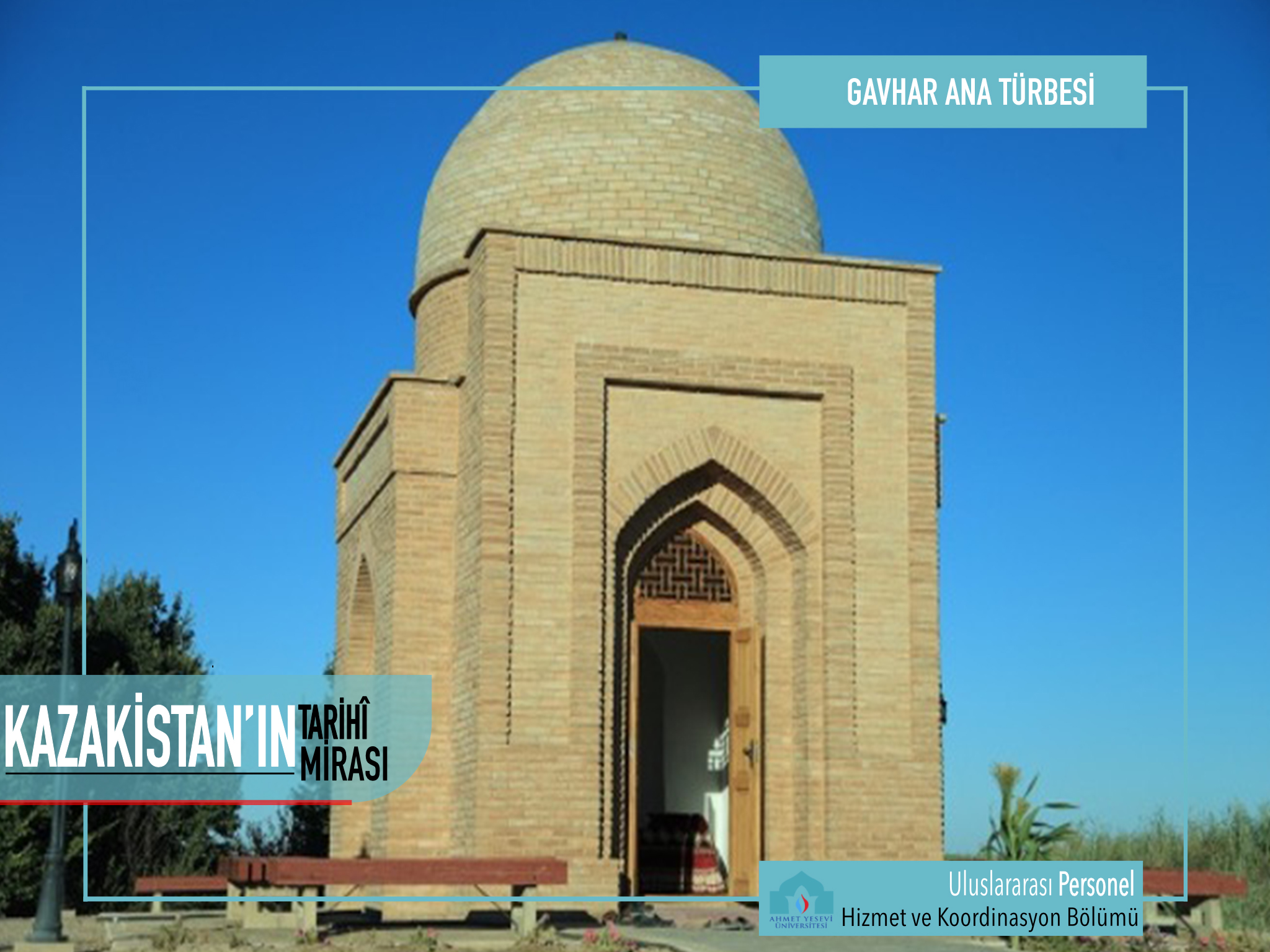
GAVHAR ANA MAUSOLEUM
(XII-XIV centuries.) It is located 4 km south of Turkestan, 400-500 metres of the Turkestan-Shauldir highway, on the left side. It is shaped like a small hill about 20 metres wide. The first grave consists of a ruined, roofless, four-sided wall. In the 1990s a cemetery building with three rooms was built next to the tomb. The dimensions of the mausoleum are 9 m, the height of its four sides is 6 m, it is a one-storey building. The total land area is 8.0 hectares.
Mother Gavhar is the daughter of the great poet and thinker Khoja Ahmet Yesevi. According to legends about Mother Gavhar, she had unique healing properties. Near the mausoleum there are still many artesian wells with healing properties.
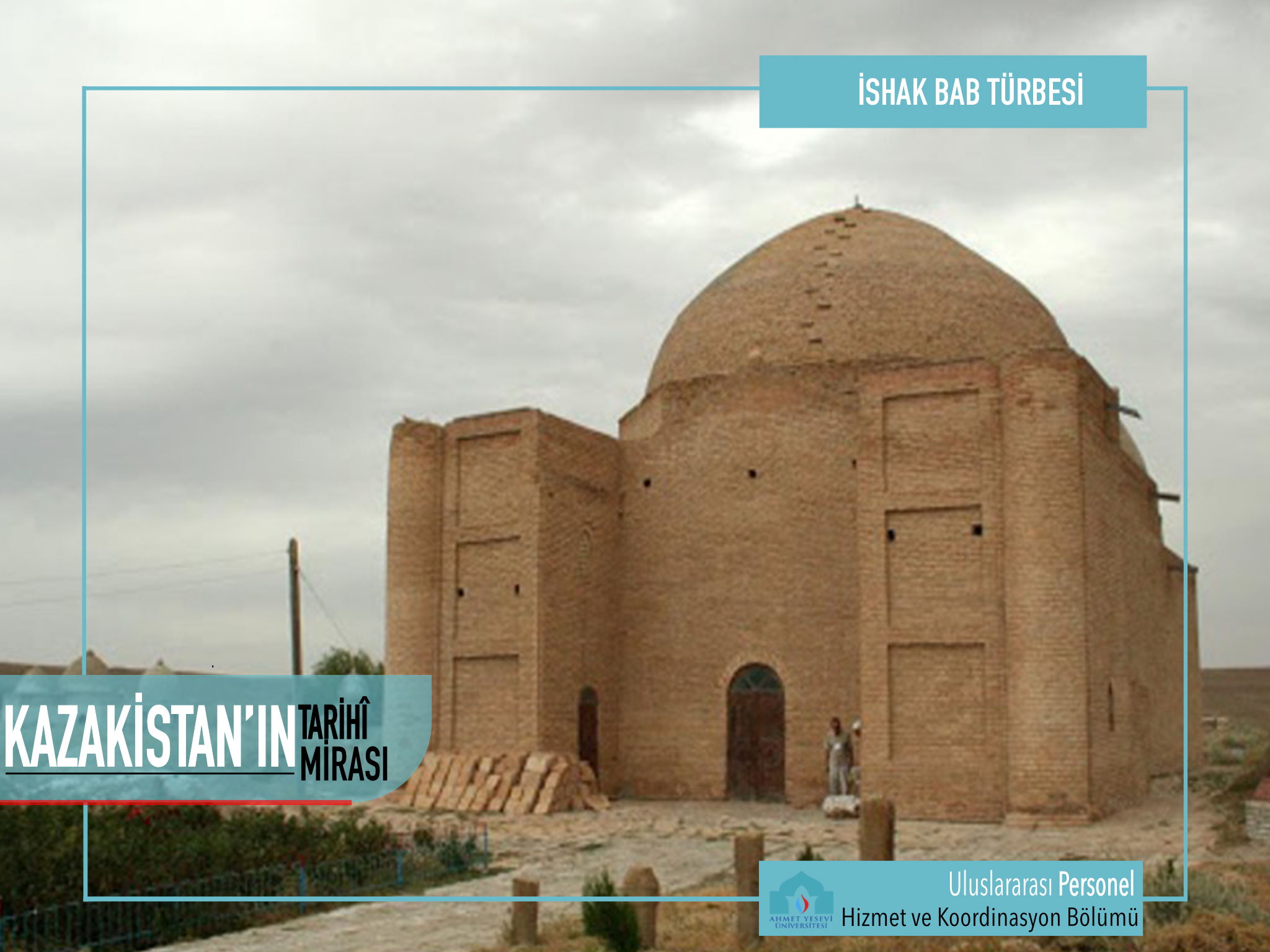
İSHAK BAB MAUSOLEUM
The monument is located in a cemetery on the northern outskirts of Baba Ata village in Suzak district. Baba Ata (Iskak Bab) was one of the most influential clergymen of the Turkestan region. In the XIX century, a new mausoleum was built over his destroyed grave. The total size of the structure is 21x13 metres. The roof is built of brick with two domes. The interior was plastered and the walls were decorated with mihrabs.
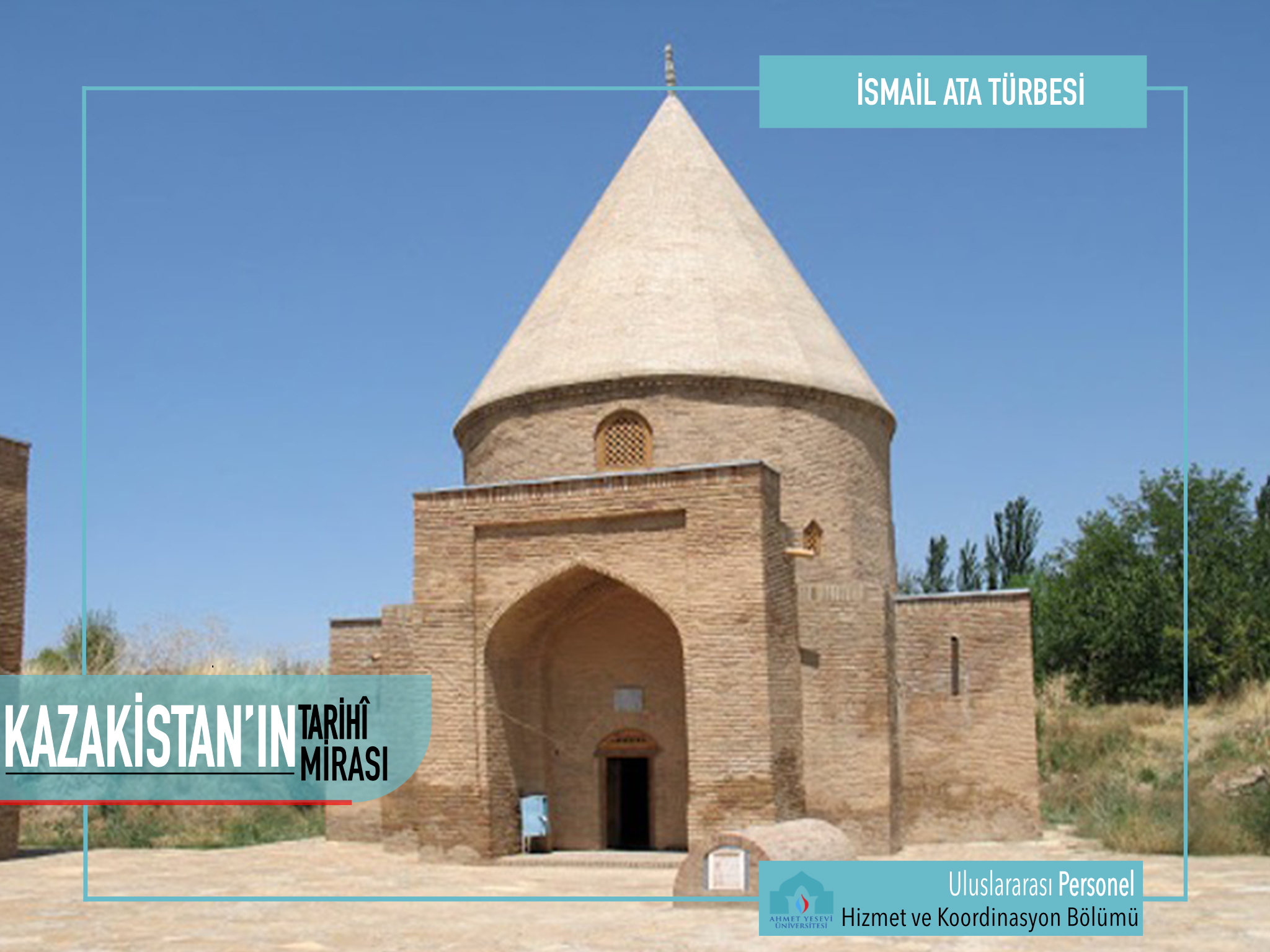
İSMAİL ATA MAUSOLEUM
The mausoleum of Ismail Ata is located in the old cemetery in the village of Turbat in the Kazıgurt district of Turkestan. The mausoleum is made of brick with a single dome. There is a walnut tree pole on the dome. The total size of the dome is 10x12 m and its height is 6 m. In 2006, reconstruction works were carried out within the scope of the Cultural Heritage Programme.
The great Persian poet Abdrakhman Jami in his book "Nasaimul-Muhabbat Min Shamail-Futuvat" mentions that Ismail Ata was the son of Ibrahim, the younger brother of the Turkish scholar Khoja Ahmet Yesevi. The mausoleum was built in honour of Sheikh Ismail Ata, a prominent representative of Islamic Sufism who lived in the X-XI centuries. The mausoleum was first built in the XI century. In the XIV-XV centuries, during the Timurid Dynasty, the mausoleum was rebuilt and transformed into an architectural complex.
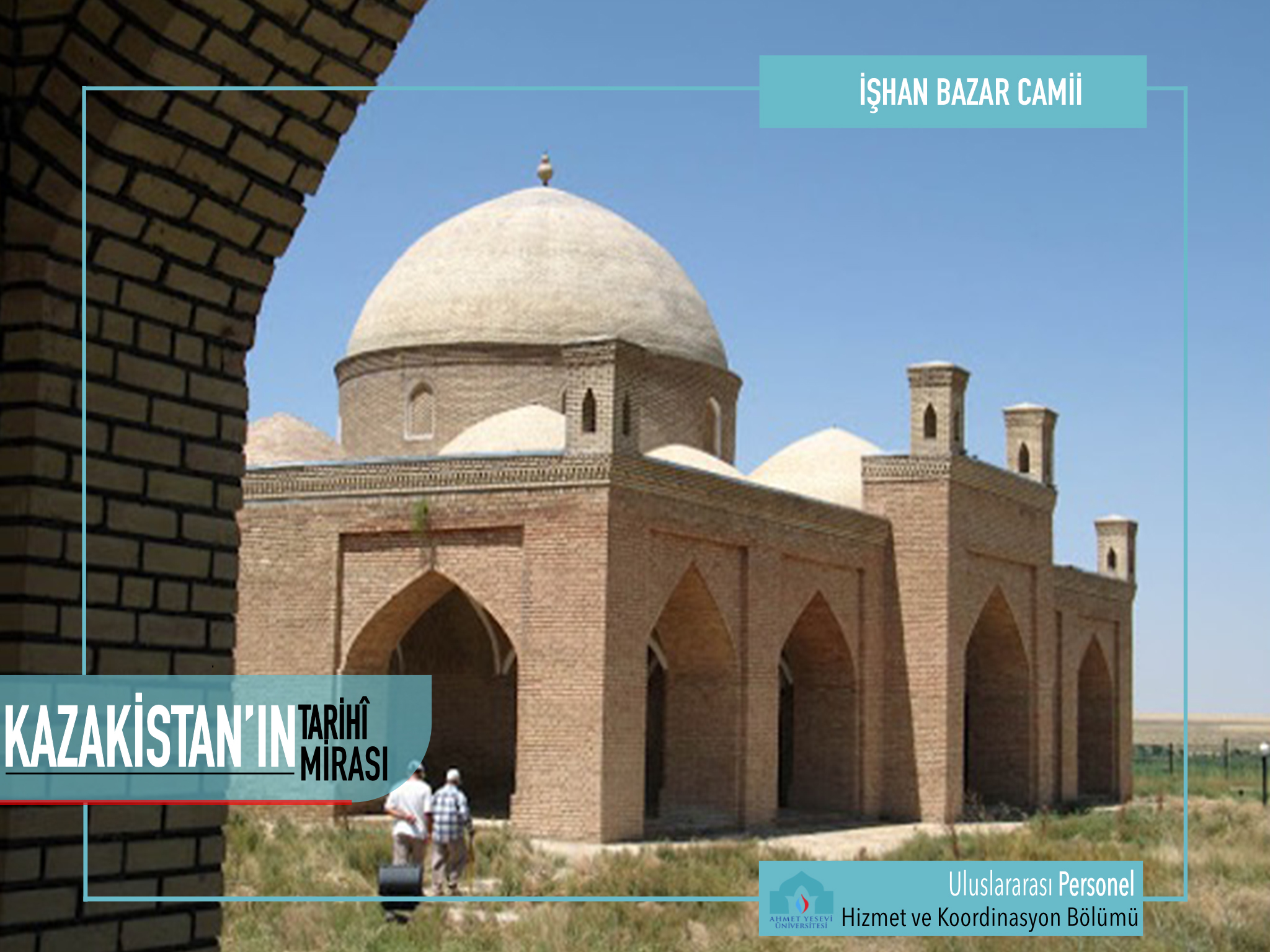
İŞHAN BAZAR MOSQUE
Located in the village of Akkoyli, Ordabasi district, this building was built in the late nineteenth and early twentieth centuries by Egember, who studied religion in Bukhara for more than thirty years and earned the title of Iskhan. At first, modern, religious, social and cultural events were organised here. Every week people gathered in the bazaar, and national games such as wrestling and races were watched on holidays. That is why the monument was called "Ishan Bazar Mosque". Later it was named "Akkoyli Madrasah" because of the local tribes. Ishan-Bazar mosque was built of burnt mudbrick. The domes and walls of the roof reflect the style of its time. The mosque consists of a large hall at the entrance and 13 small rooms.
Nowadays, this building, which attracts tourists as an important architectural monument, needs a modern restoration.
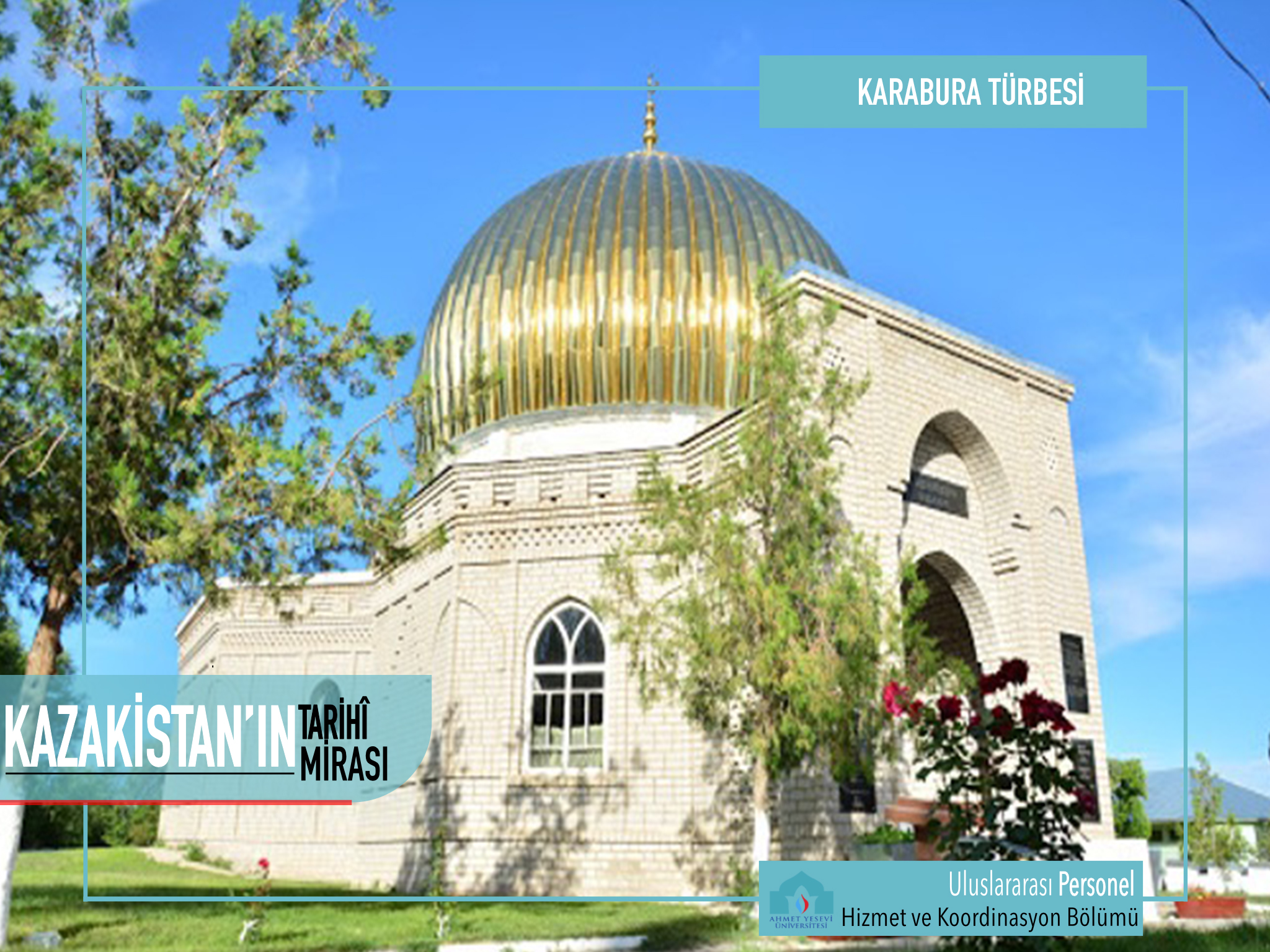
KARABURA MAUSOLEUM
The mausoleum is located in the central part of Suzak village of Suzak district. Karabura is an Oghuz-Kipchak religious figure and saint who lived in the XI-XII centuries. He belongs to the Tama tribe of the Young Jüz. He lived on the Shu, Talas, Sirdarya, Volga and Ural rivers. Karabura helped to establish Islam and its beliefs without violating Saharan traditions. He was interested in the great representative of Sufism, Khoja Ahmet Yassawi.
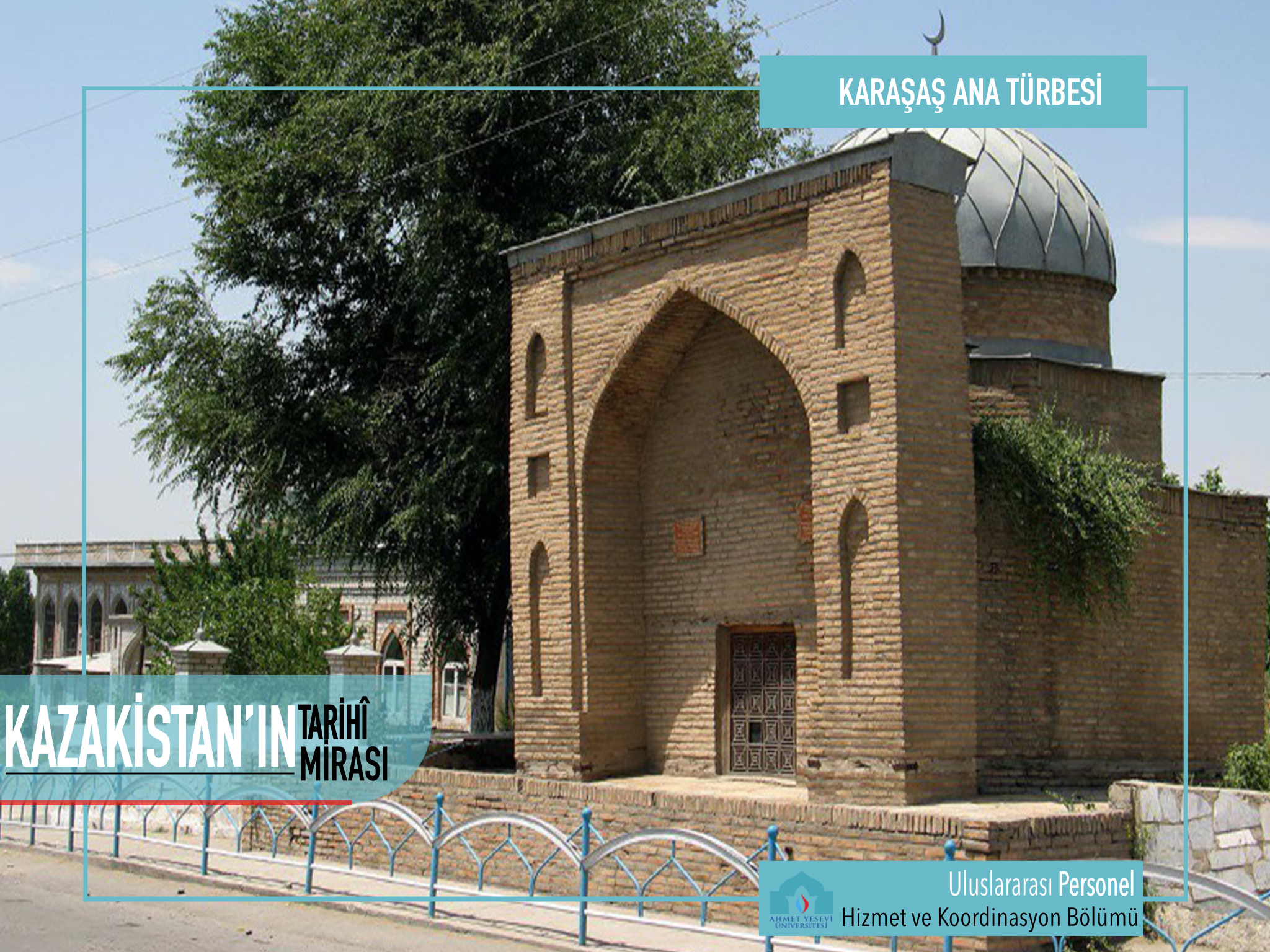
KARAŞAŞ ANA MAUSOLEUM
Sayram is located in the central part of the residential district of Shymkent. Such structures were common in the territory of South Kazakhstan in the late Middle Ages. It was originally built in the XIII century. Later, under the influence of time and natural conditions it was destroyed and rebuilt several times. The new mausoleum was built in the middle of the XIX century.
The real name of Ana Karashash was Aisha Bibi, daughter of the famous Sayram Musa Sheikh. The XI century, when Aisha Bibi lived, was a period of development of science, art and culture in the region. Mother Karashash, the mother of the great scholar Khoja Ahmet, was one of the most open-minded, polite and educated women of her time. Mother Karashash is respected by the whole Turkic world. She is recognised as a symbol of chastity. According to legends, Karashash is a person who can cure diseases and interpret dreams. Therefore, she is very famous among the people. He knew by heart the Koran, the foundations of Islam. He managed to spread the principles of Islam among the people. Because of these qualities of Aisha Bibi, the people respectfully called her "Mother Karashash".

KAZIGURT MOUNTAIN
It is located 35 km south of Shymkent. It stretches for 55 km from north-east to south-west. Its length is 22 km and the terrain is 10 km. The highest point is located in the eastern part of the ridge (1768 m). Although it is a low mountain, it is recognised as the most sacred mountain in the world. In the past, when the world was flooded, only Kazıgurt mountain remained on the water surface.
At the summit of Kazıgurt mountain there is a less flat land on the western side. Noah's ark is said to be here. In terms of introducing the centuries-old history of our country to the world, opening Kazıgurt to visit is very important for the Kazakh people.
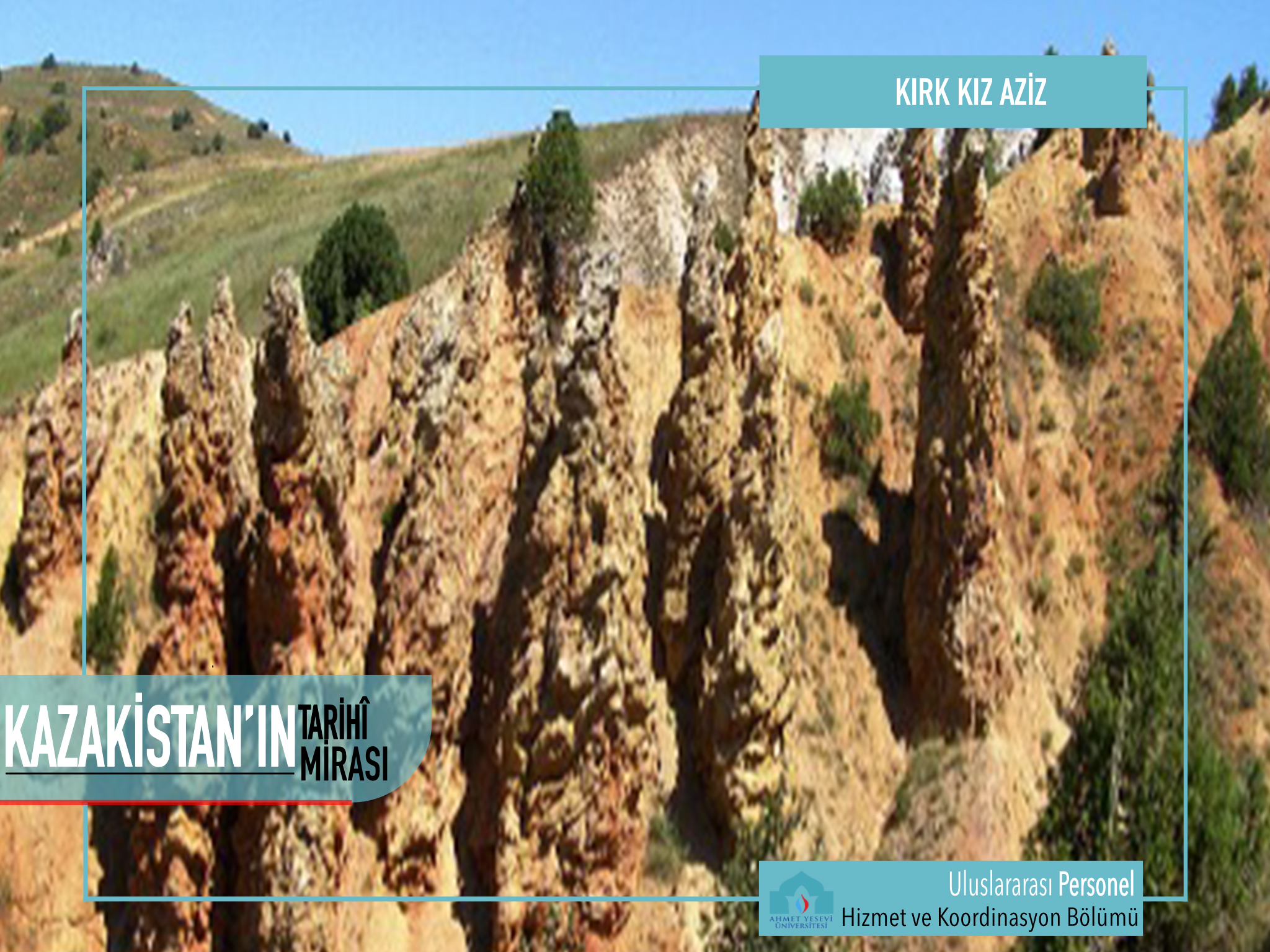
FORTY GIRLS
It is located at the entrance to Ugam village in Kazigurt district. Forty Girls is a historical and natural monument. There are two monuments in the Kazıgurt region. It has long been recognised as a sacred monument created by nature.
According to the legends, during the war days the enemy invaders saw 40 girls swimming in the waters of Karabakh and walking carelessly towards the country and chased them. Then the girls prayed to God: "Instead of crushing this country of mine and my land over the enemy, turn our enemy and us into stone!". The girls' prayer was answered and the enemy army turned to stone. The name of this place was named Karataş after that. It is said that the girls became a unique monument with beautiful decorations. These monuments are located at the source of the Akkum River northeast of Turbat village. It is close to the waterfall, 5-6 km away from the village. The second stone sculptures called 'forty girls' are at the entrance to the Ögem cave. It is 4-5 km to the southeast of the Kazıgurt mountain. According to the legend, this is the image of forty girls turned into stone.
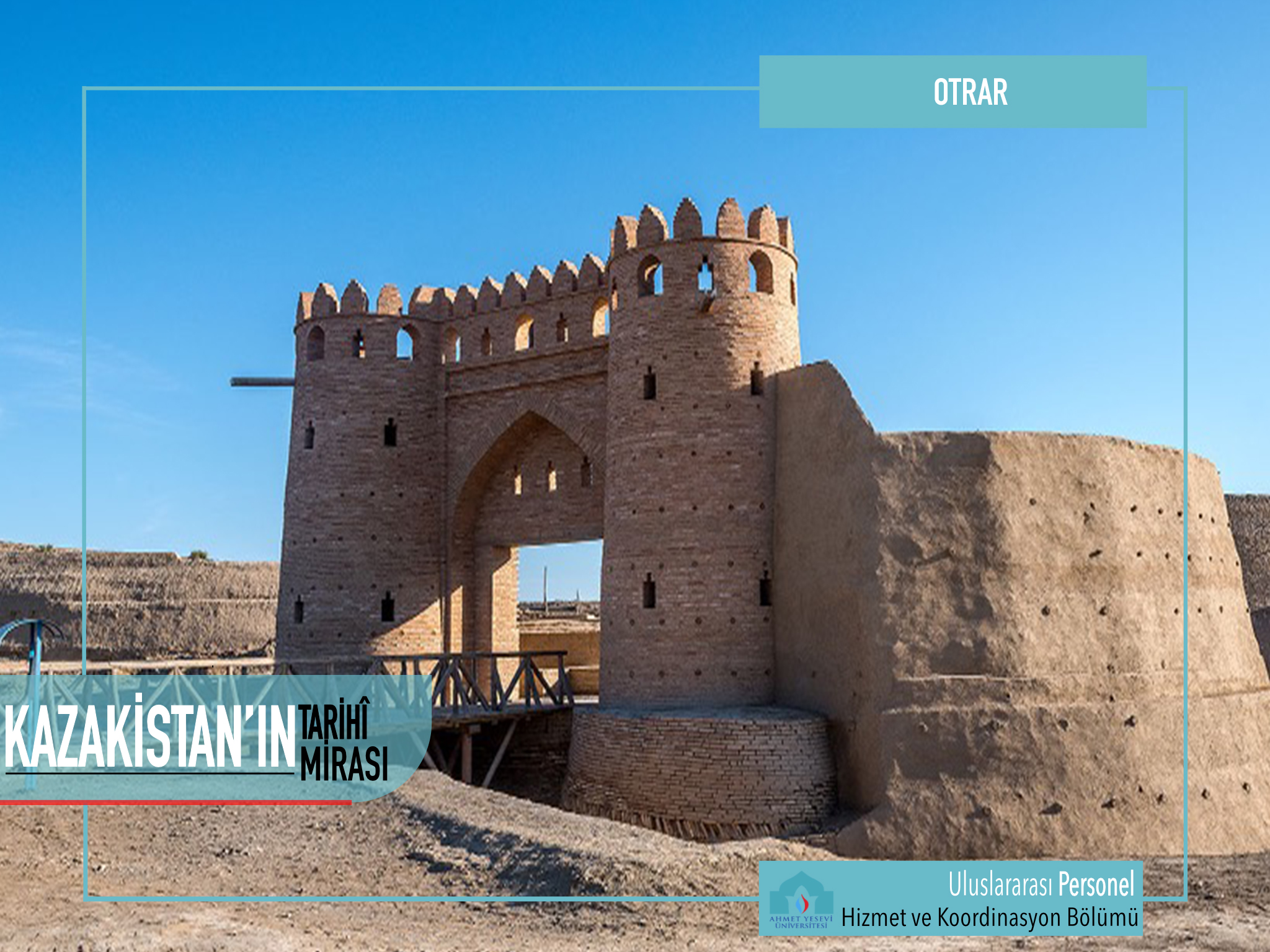
ORTAR
It is located at the southern end of the village of Talapti in the Otrar region, at the confluence of the Aris and Sirdarya rivers. The appearance of the city is characteristic of many medieval monuments of Kazakhstan and Central Asia.
The fortress and Shahristan are in the form of a five-pointed hill 18 m high. The area of the hill is 20 hectares. It is surrounded by fortress walls. Some parts of them are still at a right angle of 75-80 degrees. On the wall, there are towers preserved in the form of round hills in the form of projections. Behind the wall is a ditch in the form of a gently sloping passage, 2-3 m deep and 10-15 m wide. The entrance to the city is through three gates. Two of them are located on the south and northeast walls and the other one is located in the centre of the west wall.
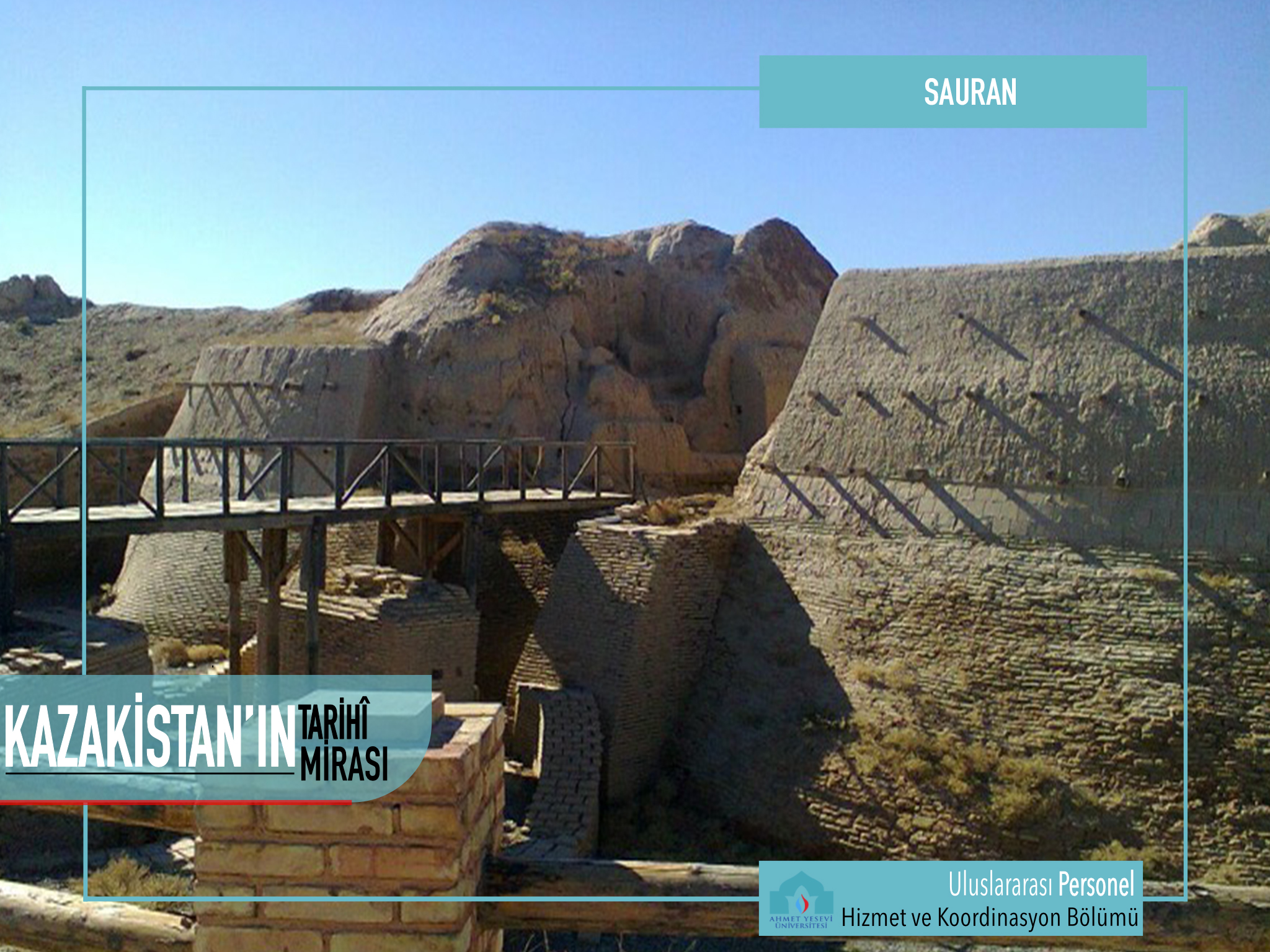
SAURAN
It is one of the most famous medieval cities of Kazakhstan, founded in the XII century as a major trade centre. The first information about Sauran is found in the works of the X century. At that time Sauran was known as an important strategic and trade centre in the Sardinia basin. Maqdisi, an Arab historian, wrote: "Sauran is a large city surrounded by a seven-storey wall with a mosque inside".
Sauran weakened in the late 17th and early 18th centuries and collapsed in the early 19th century. At present, there are the remains of the walls and towers of Sauran, a circular area with an area of 550-800 metres. You can enter the city through the gates. Outside the wall surrounding the city there are traces of many canals. Researches show that the city belongs to the VII - XVIII centuries.
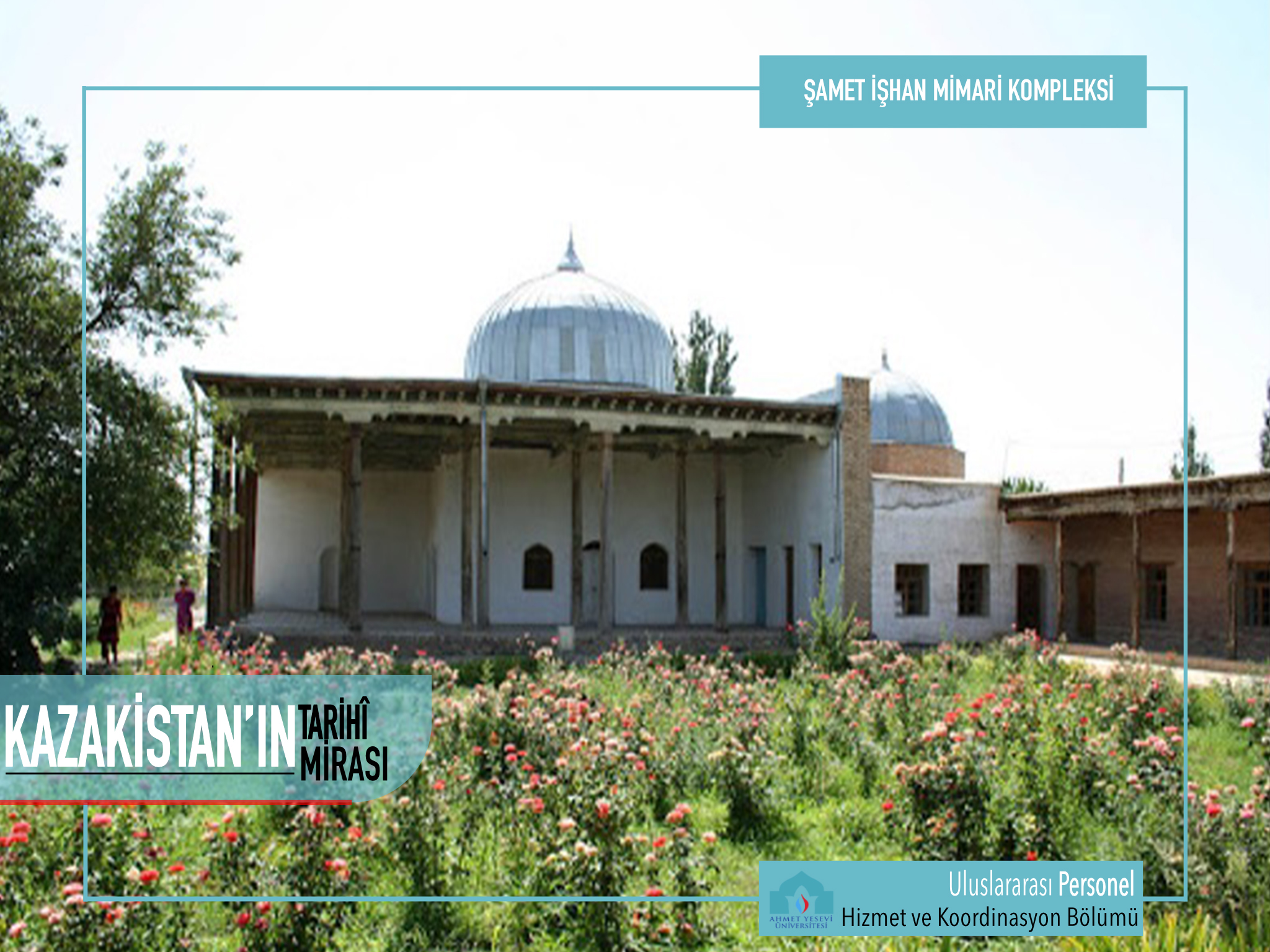
ŞAMET İŞHAN ARCHITECTURAL COMPLEX
Old Karatau is a sacred place where people have lived since ancient times. In the city of Kentau and the village of Karnak, located on the slopes of Karatau, many medieval historical monuments have been found. The mosque-madrasa "Shamet Ishan" was built in 1789, at the end of the XVIII century for the purpose of educating the local population. In 1789 the small palace was built, in 1876 the big palace was built. There is an underground temple under the small palace. On hot summer days the temple was used for worship, while the large palace served as a mosque and the first place where students learnt to read and write. The interior of the large palace is decorated with beautiful ornaments of oriental architecture. Education at the madrasah continued until 1917.
During the Soviet period the building was used for various purposes. One day, while lecturing his students, Iskhan said, "Immediately go to the Karachik River, where a woman and her child are struggling to cross the river." The students were amazed when they saw a woman in the river. The Shamet Iskhan architectural complex is located in the centre of the village of Karnak in Kentau.
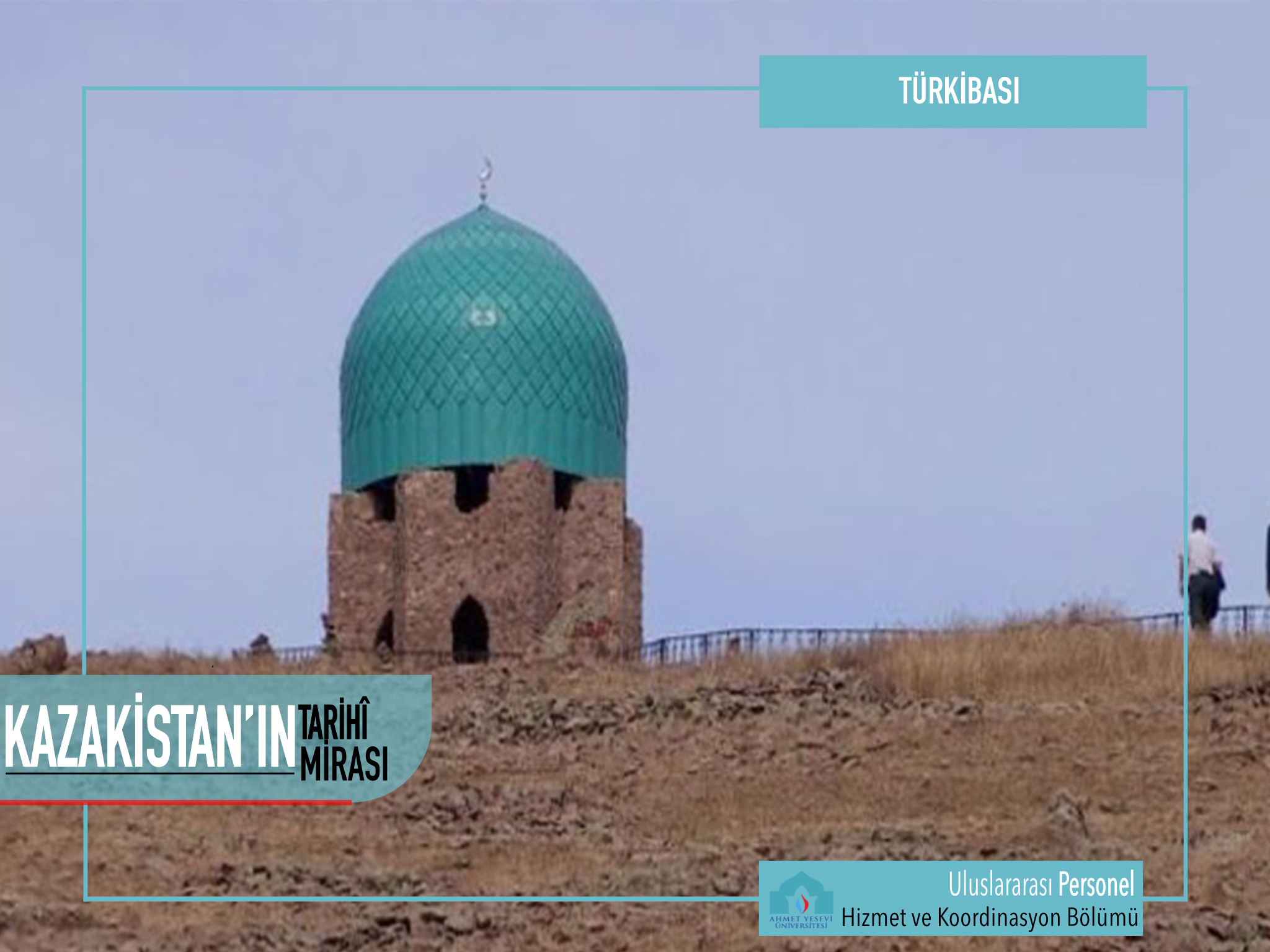
TÜRKİBASI
It is located in the centre of Turkibasi district, 2 km from the village of Turar Ryskulov near the village of Azattyk. According to legends, the ancient name of the area, located at the confluence of the Aris and Kulan rivers and now called Tulkubas, is Turkibasi. The name is associated with Estemes Khan, the head of the Western Turkic Khanate. In about 556, Estemes Khan pitched a tent and built a city on the then mountain Ekitau.
As we learn from the work of the famous scholar V. V. Barthold, "Report of a Business Trip to Central Asia" (Moscow, ed. "Science", 1966), he visited the territory of Tulkubas in 1893 and discovered that Tulkubas was an artificial and erroneous name and expressed his scientific preference for Turkibas.
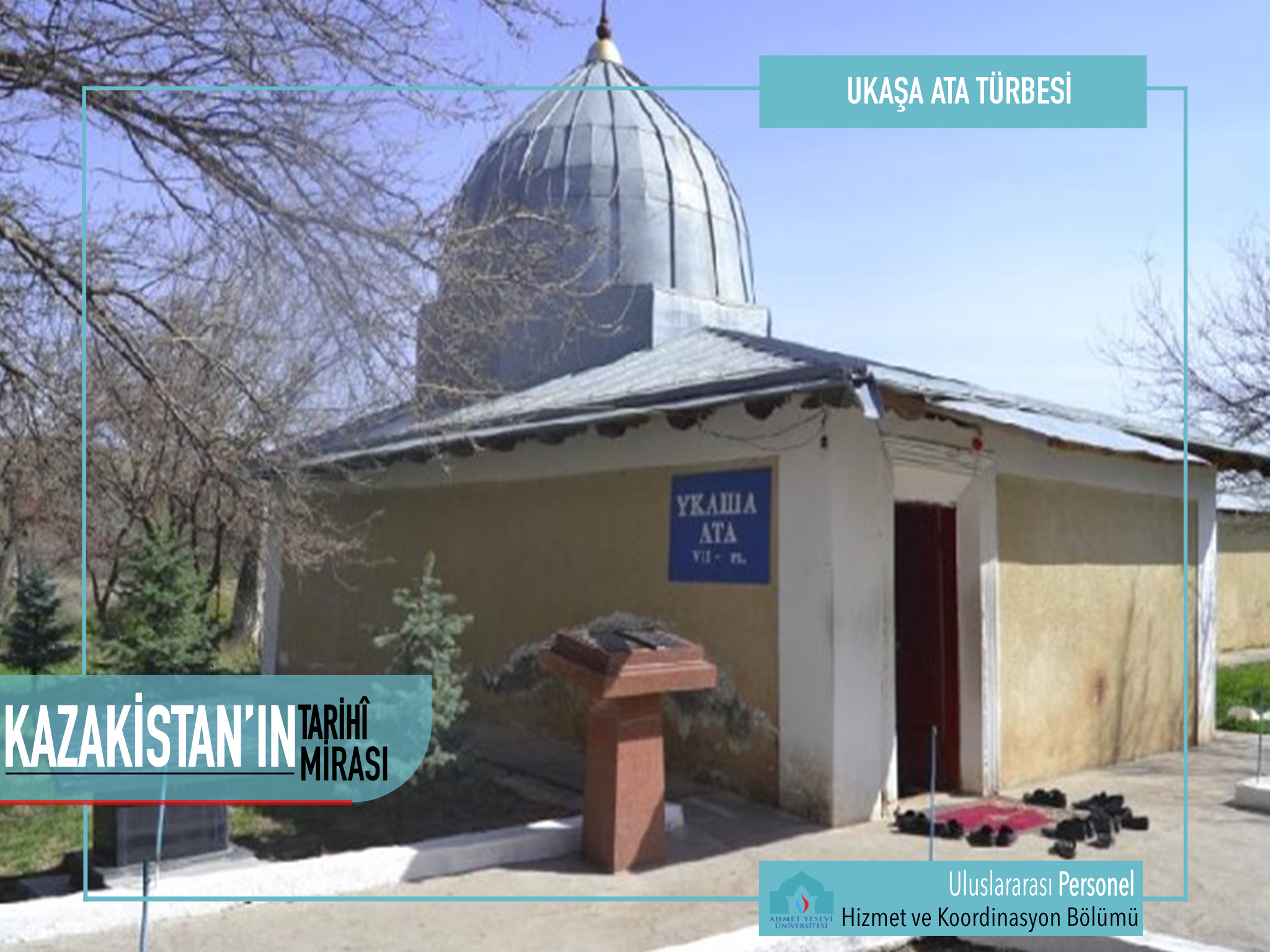
UKAŞA ATA MAUSOLEUM
Ukasha Ata Mausoleum is located 35 km north of Turkestan, north of Babaykorgan. The Companion named Ukasha is known as a historical person who first brought Islam to the Kazakh steppe. Ukasha was among the faithful companions of the Prophet. It is said that he originated from one of the Turkic tribes. During the Soviet period, the name "Gakasha" was forgotten in the historical minds of the people and was preserved under the name Ukasha Ata, Ukasha Evliya.
According to folk legends about "Ukasha-Ata"; Ukasha was a companion of Prophet Muhammad (PBUH) and military commander of Muslims. At the head of the Ukasha-Ata well, there is a small yurt-like structure with a diameter of 4.5 metres and a height of 3.5 metres. The depth of the well is 22-25 metres. All Muslim communities visit the tomb to pray to Allah and to get rid of their sins.
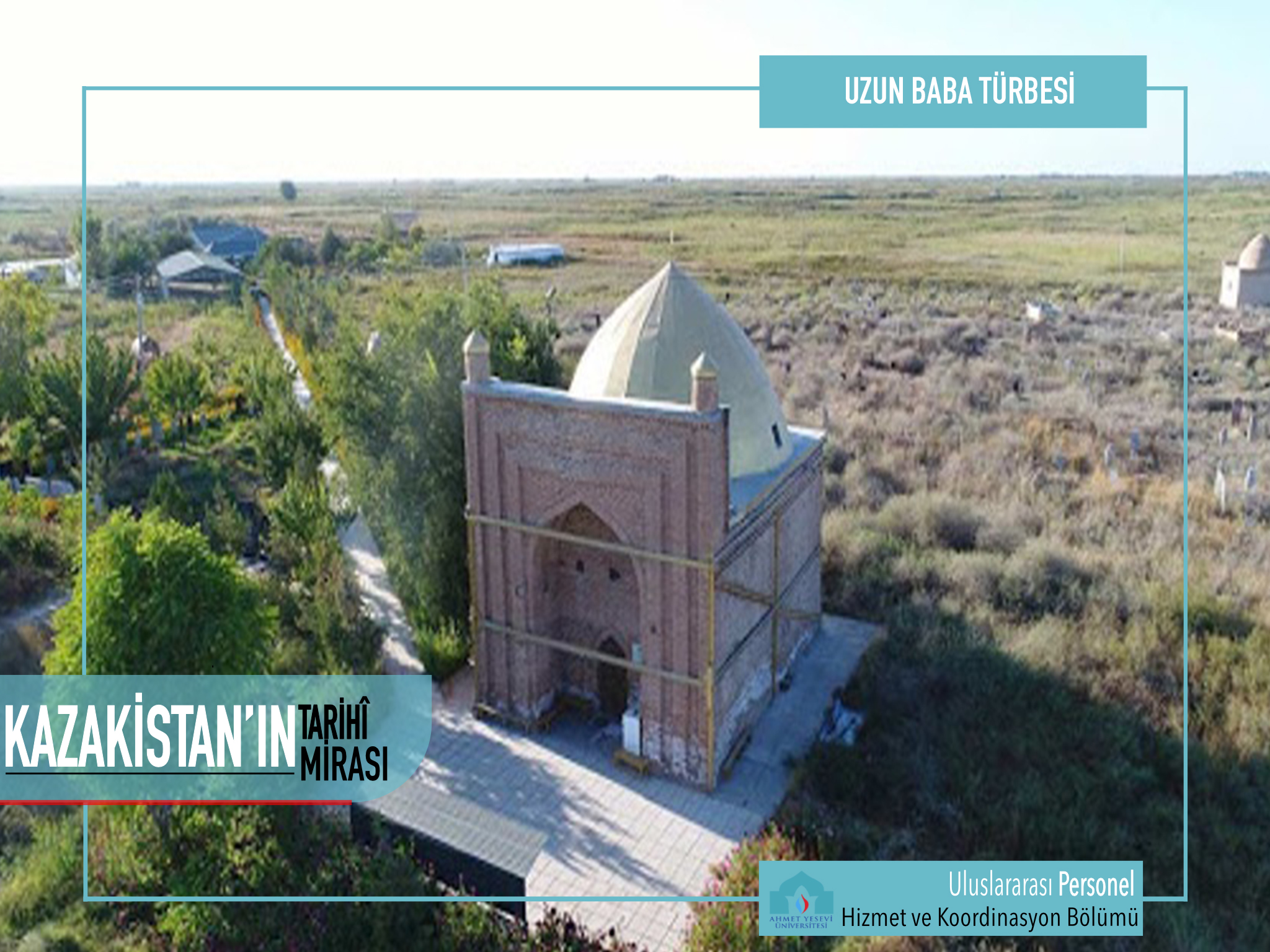
UZUN BABA MAUSOLEUM
It is located in Shardara district of Uzun Ata district. It was built by the order of Amir Temir at the end of XIV century. The mausoleum is completely built of burnt bricks. Due to his tall stature, he is known as "Uzun Ata" among the people. His real name is Asan Ata.
According to the legend; Asan Ata was the first pious person who spread Islam in the region. Ақсақ Темірдің бас кеңесшіліерінінің бірі ретінде қасында еріп жүрген. Throughout his life he was loved by the people and was considered a man of religion, social protector and saint.
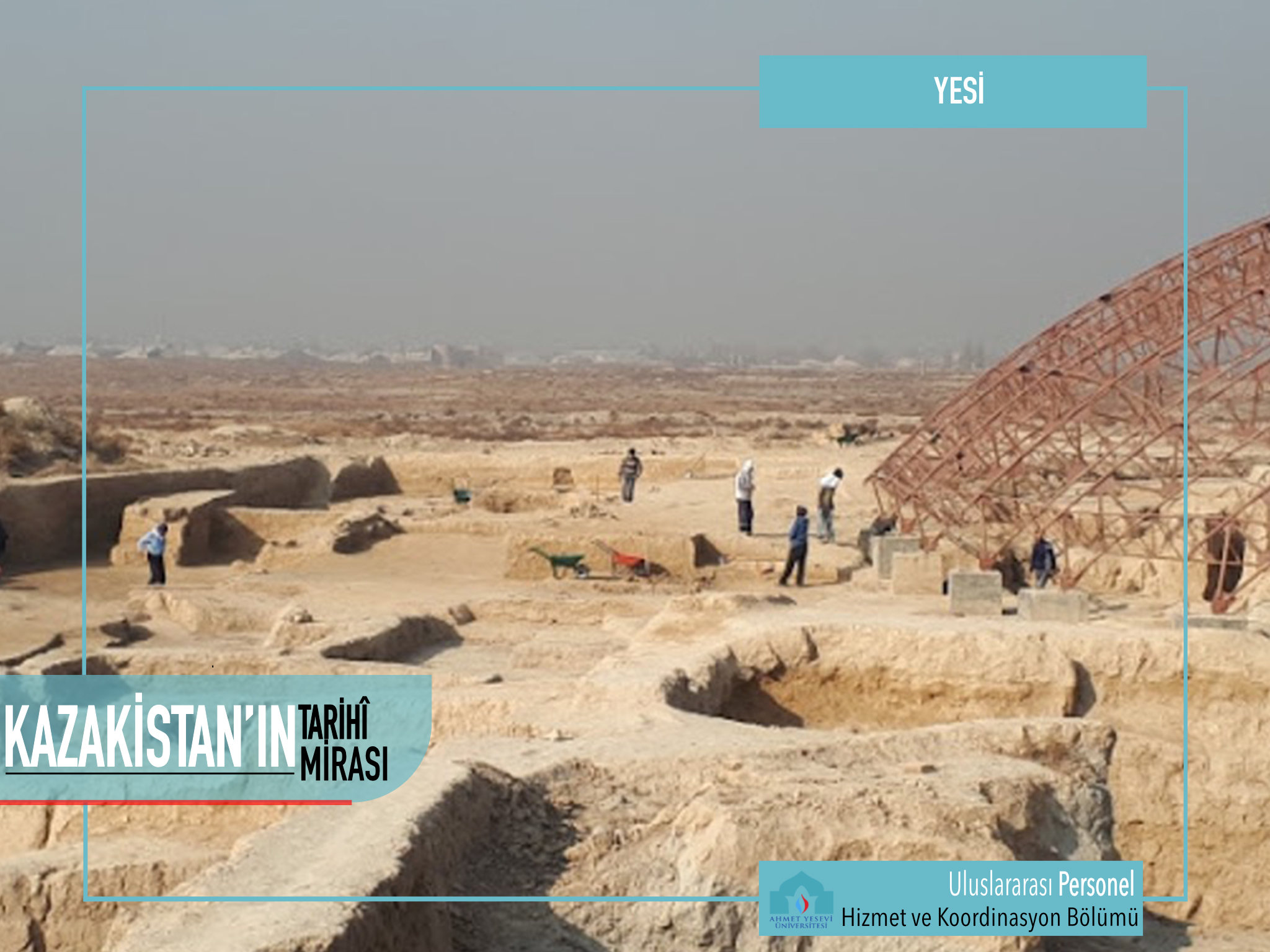
YESİ
It is one of the oldest cities of Kazakhstan, built in the V.-VI centuries. The city is located on the territory of Turkestan. Archaeologists have established that the territory of early Yesi corresponded to the present Kultebe. Kultebe is one of the oldest cities in the country. Kultobe is an oval hill with a height of 9 m and an area of 150x120 m.
In recent years, the topography of the monument has changed significantly. In the 19th century, the Kultöbe plateau was surrounded by fortress walls, like the whole of South Rabat. Kultöbe is based on the military system of medieval Turkestan.
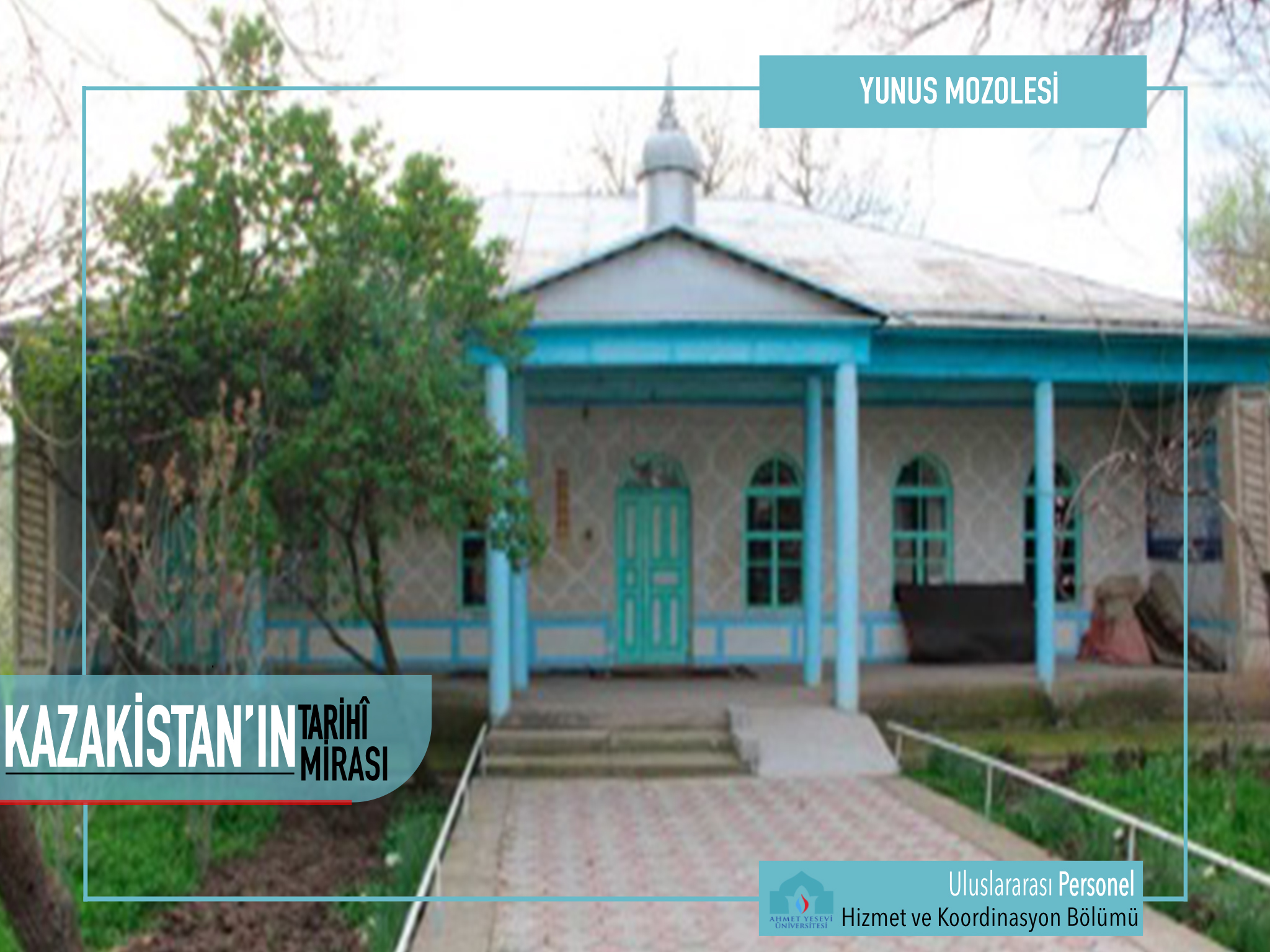
YUNUSMOZOLES
The mausoleum dedicated to Joseph-Junus-Yunus Ata, who lived in the XII century, is located in the mausoleum of "Jusip Ata" in the village of Eski Ikan in Turkestan. The mausoleum consists of two rooms. The cemetery in the south-eastern part is built on a 4x4 metre mausoleum built in the XII century. The second room is a mausoleum room with a domed roof. The walls are made of burnt bricks.
According to folklore narratives, Yunus was Ahmet Yesevi's nephew. Some sources say that he was a disciple of Yesevi.
